scm 4301 dale tibodeau exam 2
1/180
There's no tags or description
Looks like no tags are added yet.
Name | Mastery | Learn | Test | Matching | Spaced |
|---|
No study sessions yet.
181 Terms
lecture notes 6
product characteristics:
*product offering
-tangible part (physical characteristics)
-weight, volume, shape, performance, durability, etc.
-intangible part (service characteristics)
-after-sales support, company reputation, timeliness, responsiveness, etc
*product offering = tangible + intangible
product classification:
*consumer products
-convenience
-shopping
-specialty
*industrial products
product life cycle:
introduction --> growth --> maturity --> decline
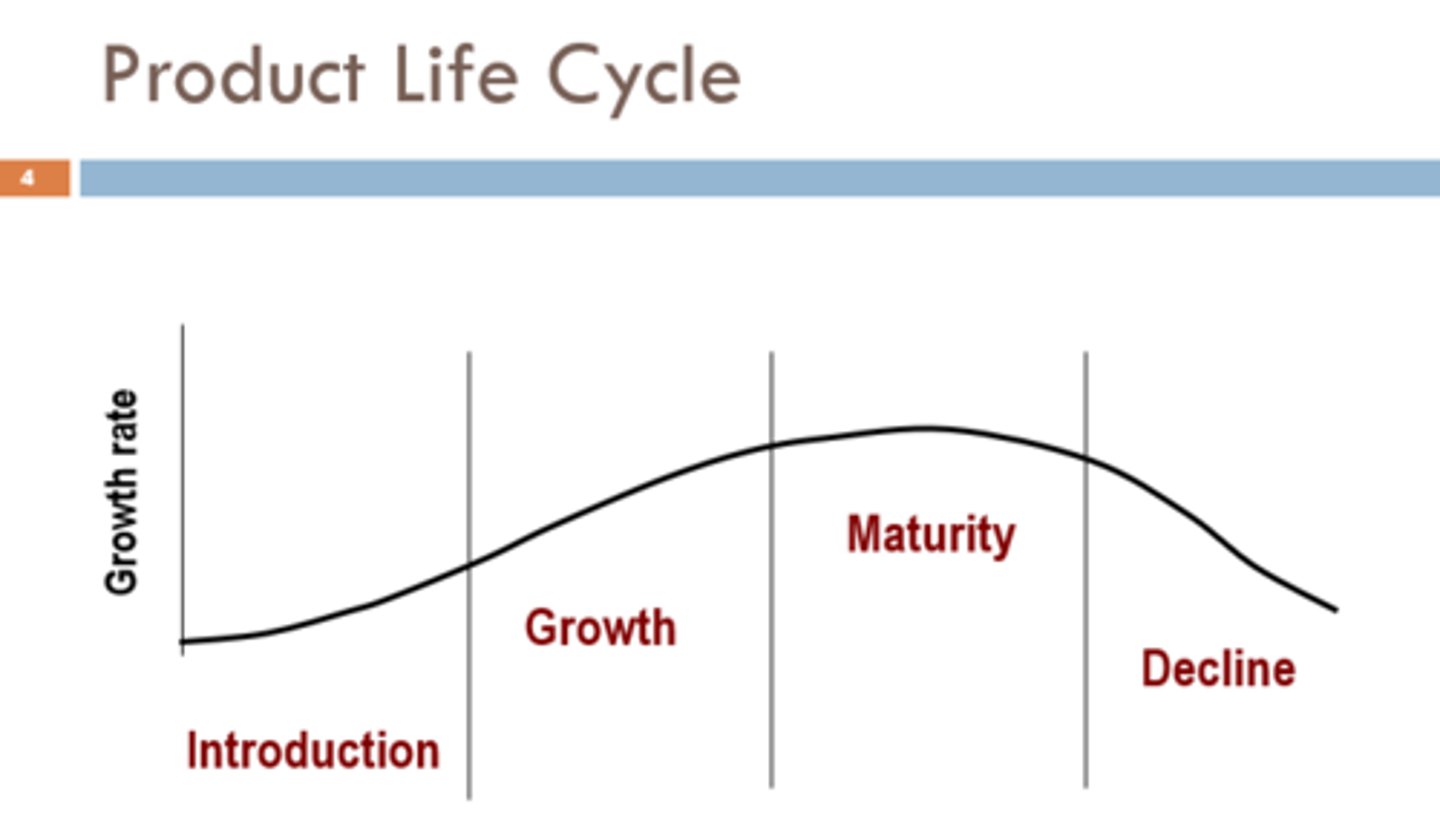
product life cycle, sales, cost and profit:
*in the first stages of the product life cycle, there's a lot of money and resources spent but because significant volumes haven't been produced yet, break even or profit doesn't happen yet
*profit comes in the later stages after there's been growth and mature products.
*with this graph, you can see what period in the cycle there's profit or loss.
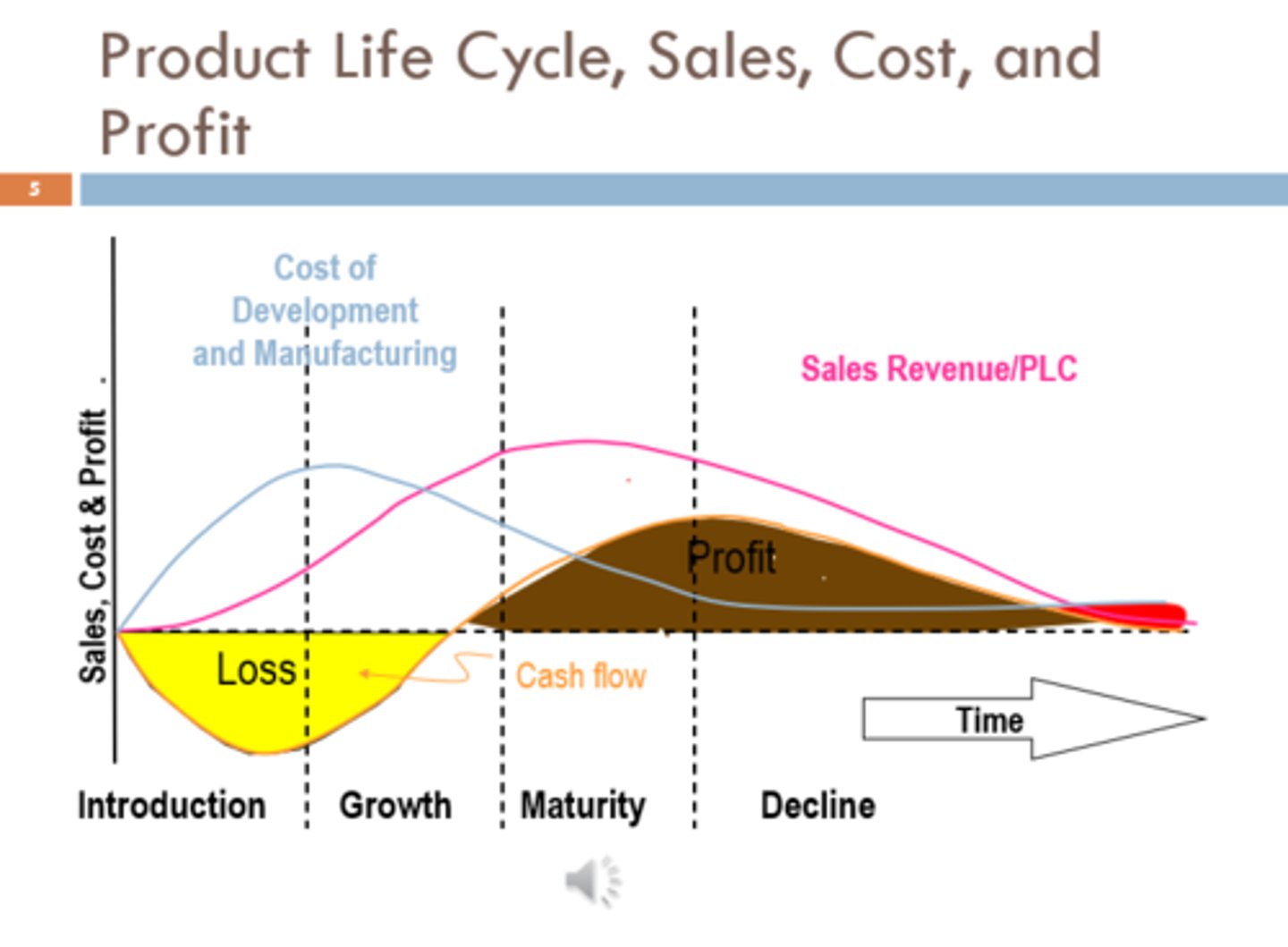
strategy and issues during a product's life:
"at what stage are these products in their life cycles?"
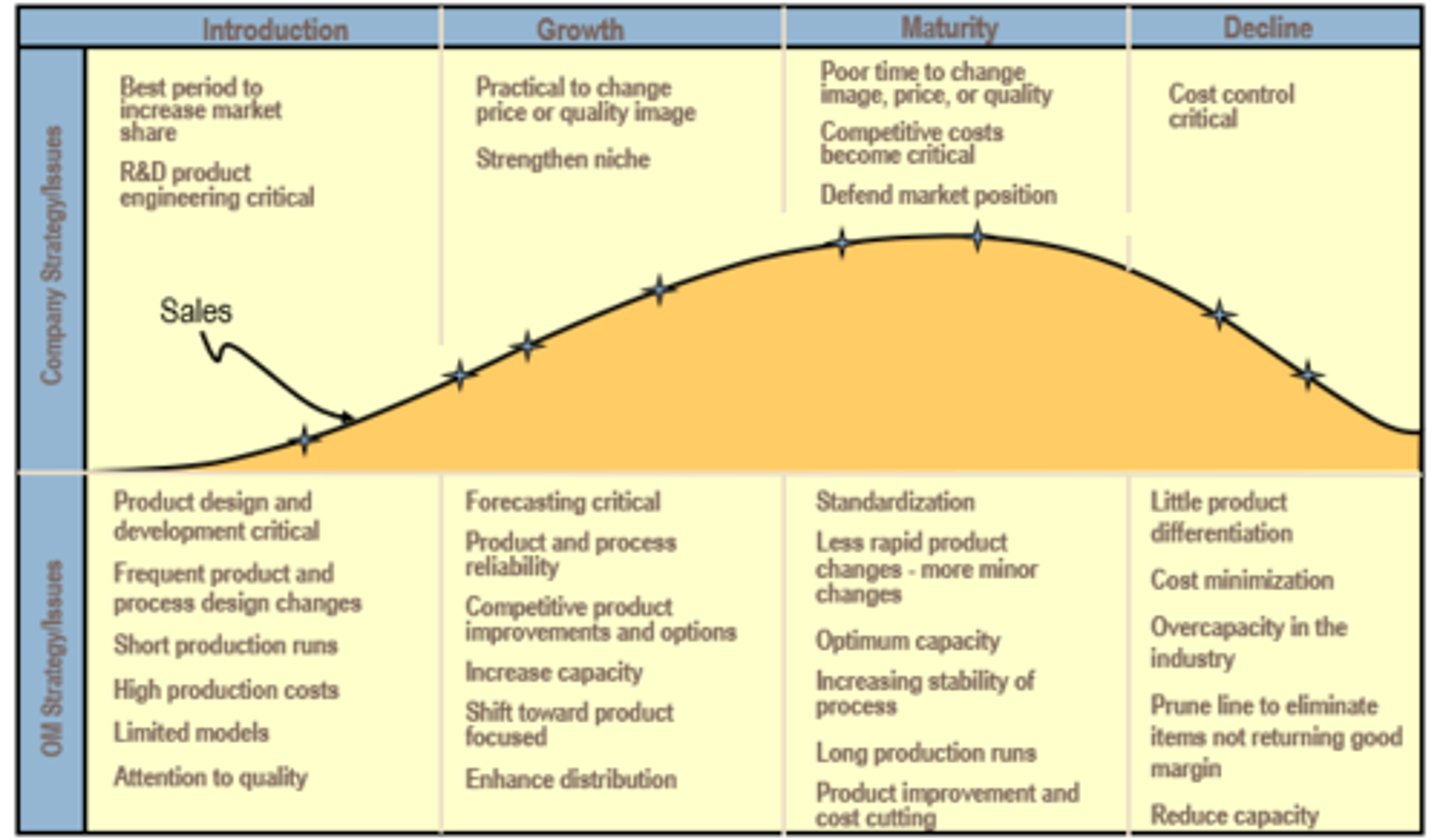
abc classification:
*80-20 rule
-pareto's law
-"80% of firm's sales are generated from 20% of the product line items"
-useful in distribution planning and inventory control
-vital few - trivial many
classifying items as abc:
note on abc analysis:
*80-20 guideline is only a guideline
*"a" items could be:
-15% of items account for 75% of sales
-25% of items account for 85% of sales
-20% of items account for 90% of sales
-30% of items account for 70% of sales
abc classification for 14 products:
see image

cumulative 80-20 curve:
see image

abc example:
suppose that in an inventory of 10 line items 15% of the items account for 80% of the annual sales volume. total annual sales (all items) are $90,000. classify the items according to abc analysis.
*each item accounts for 10% so to get 15% of the items, you'd have to choose two because that equals 20%. that covers 15% rather than choosing just one item since that only accounts for 10%
*80% * $90,000 = $72,000
*10% of $90,000 = $9,000
*$9,000 * 2 = $18,000
it
*90,000 - 18,000 = $72,000
*there's not enough information to perform a full calculation
abc practice problem:
a drug retailer wants to apply pareto's law and conduct an abc analysis of its 12 line items in inventory
*product code and annual sales are shown in the image
*find the a, b, and c items in this inventory
*got to take the sales volume and sort from highest to lowest. then add up total sales and look at how much the cumulative total is and see where you hit the 80-20 % you want to pick. because there's 12 items, each item would be 1/12.

abc practice problem 1:
stratify the following items into a, b, c categories. 60% of the revenues represent a, 20% represent b, and 20% represent c
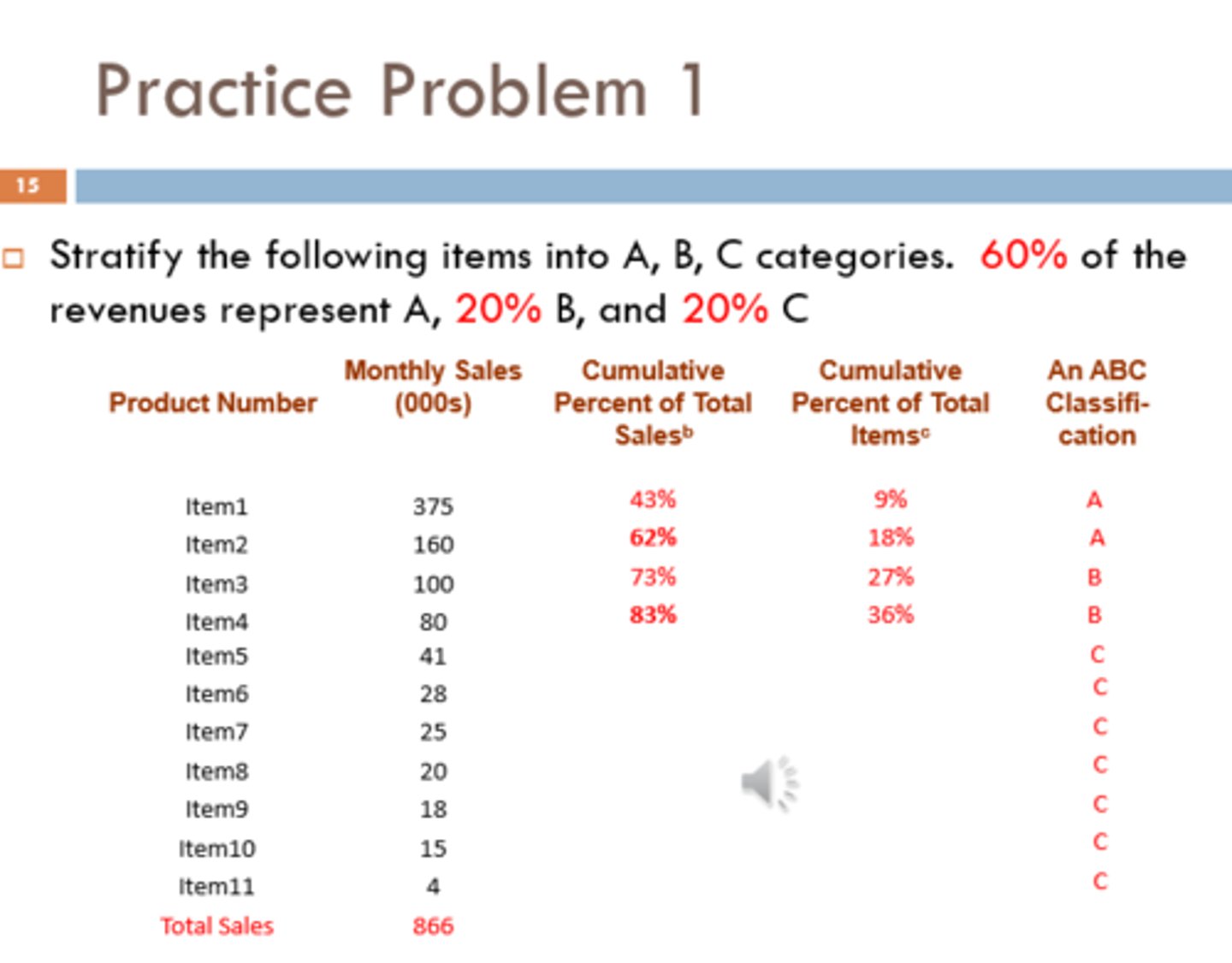
different abc classification:
*based on sales (previous examples)
*based on hits
-number of times a customer buys the product
*based on profit margin on inventory investment
-a high revenue product, could also be low on profit margin
*combine all three dimensions
a combination example:
see image
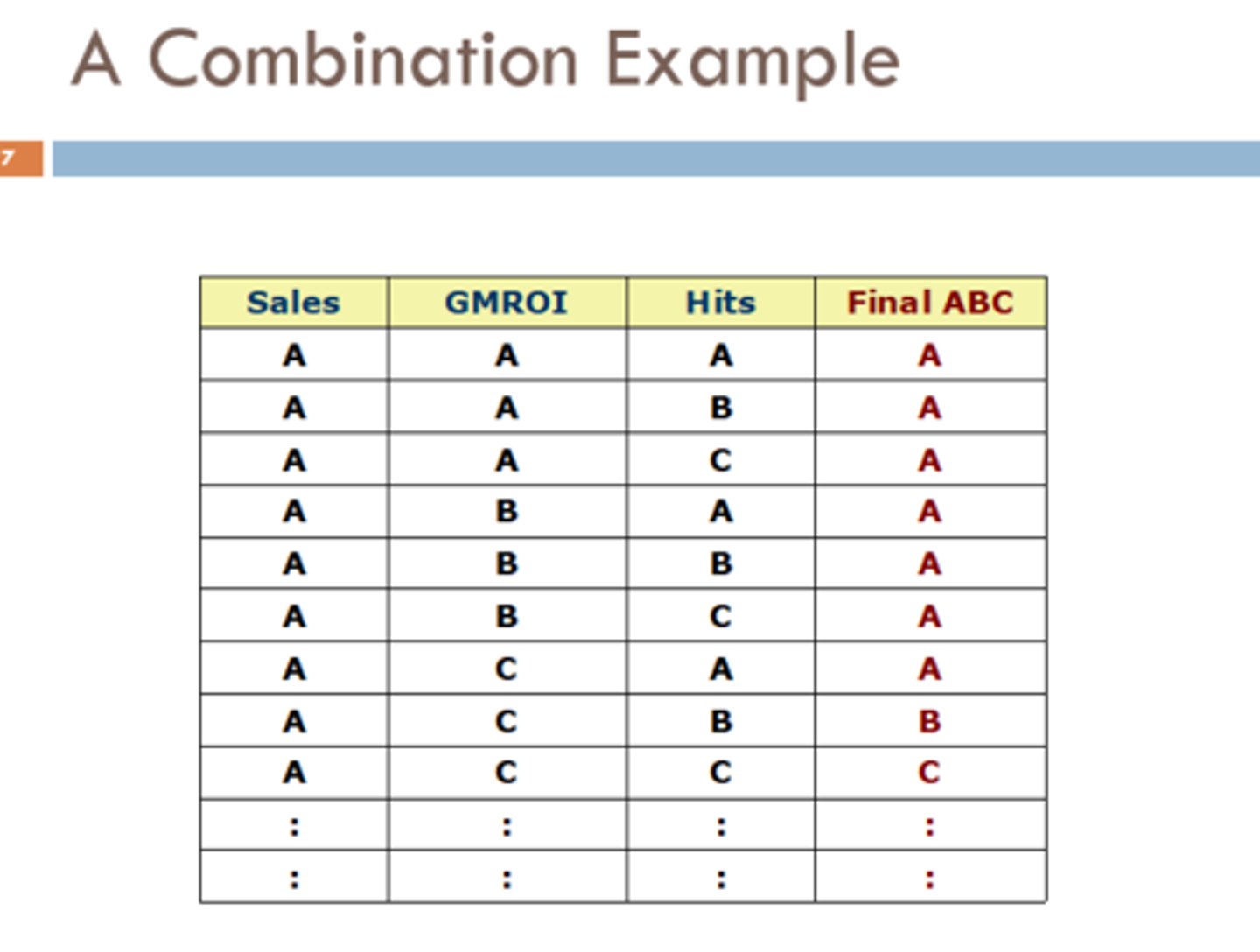
additional categories:
*d - very slow items
*dead
*new items (no revenue or sales history)
*x and y items - if you don't stock them
*categories that make sense - too many will not help
purpose of classification/stratification:
*define logistics strategy
-where to stock?
-how much to stock?
-safety stock levels
-service levels
-set profit margin/prices
-allocate resources
-to sell or not to sell
product pricing (in logistics):
*geographic pricing methods
-fob pricing
-zone pricing
-single, uniform pricing - single price for all customers regardless of their location. ex: first class letter
-freight equalization pricing - if two firms have equal efficiency in producing and selling which results in same product costs at factory locations then competitive pricing is a matter of transportation costs. the firm with higher transportation costs may wish to absorb the added cost to remain competitive
-basing point pricing - establishes some point other than the one from which the product is actually delivered as the point which to compute price. if location chosen is the location of a major competitor, prices can be forced to be similar to the competition
*incentive pricing
fob:
*fob pricing - "free on board" or "freight on board"
-the fob factory (the fob origin)
-the fob destination
*different types
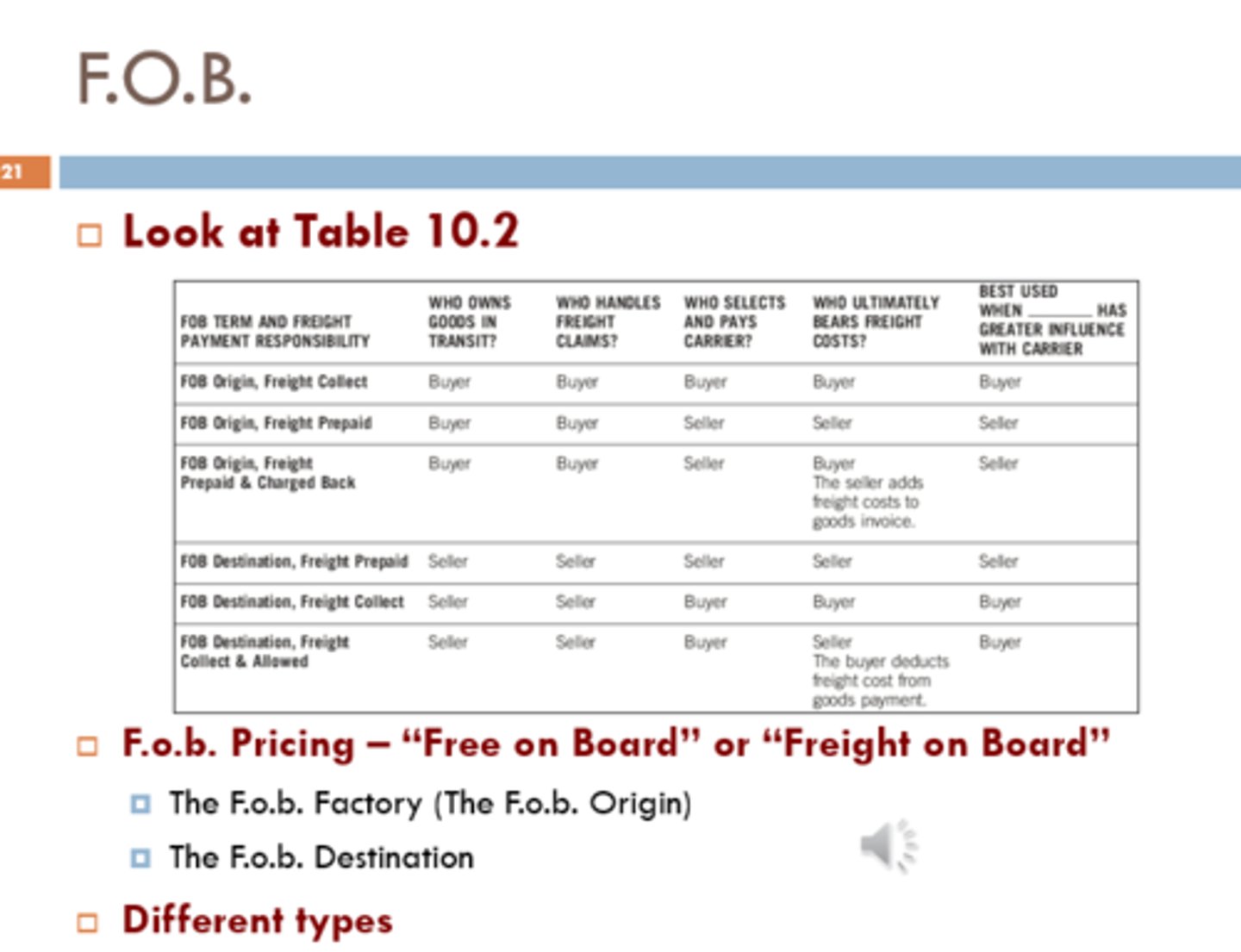
terms of sale - fob origin, freight collect:
*freight charges paid by buyer
*title passes to buyer
*buyer pays freight charges
*buyer bears freight charges
*buyer owns goods in transit
*buyer files claims (if any)
terms of sale - fob origin, freight prepaid:
*freight charges paid by seller
*title passes to buyer
*seller pays freight charges
*seller bears freight charges
*buyer owns goods in transit
*buyer files claims (if any)
terms of sale - fob origin, freight prepaid and charged back:
*freight charges paid by seller, then collected from buyer by adding the amount to invoice
*title passes to buyer
*seller pays freight charges
*buyer bears freight charges
*buyer owns goods in transit
*buyer files claims (if any)
terms of sale - fob destination, freight collect:
*freight charges paid by buyer
*title passes to buyer
*buyer pays freight charges
*buyer bears freight charges
*seller owns goods in transit
*seller files claims (if any)
terms of sale - fob destination, freight prepaid:
*freight charges paid by seller
*title passes to buyer
*seller pays freight charges
*seller bears freight charges
*seller owns goods in transit
*seller files claims (if any)
terms of sale - fob destination, freight collect and allowed:
*freight charges paid by buyer, then collected from seller by deducting amount from invoice
*title passes to buyer
*buyer pays freight charges
*seller bears freight charges
*seller owns goods in transit
*seller files claims (if any)
zone pricing:
*prices are same when you ship to any location within a zone
*used in package shipping - usually defined by the distance or the network of the logistics provider
*shipping time also is similar when you ship to any location within a zone
*UPS and fedex websites provides zone details for any zipcodes
incentive pricing:
*there are choices that businesses make to save money on freight or transportation
*if you're not filling a truckload, it'll cost more than if you fill a truck. so sometimes you'll bundle or consolidate orders you want to ship daily to a location. or queue up goods over 2 or 3 days until you have a full truck load quantity and this will give a larger savings amount.
*there's also different freight choices such as rail which is cheaper than truck especially for longer distances but it is slower
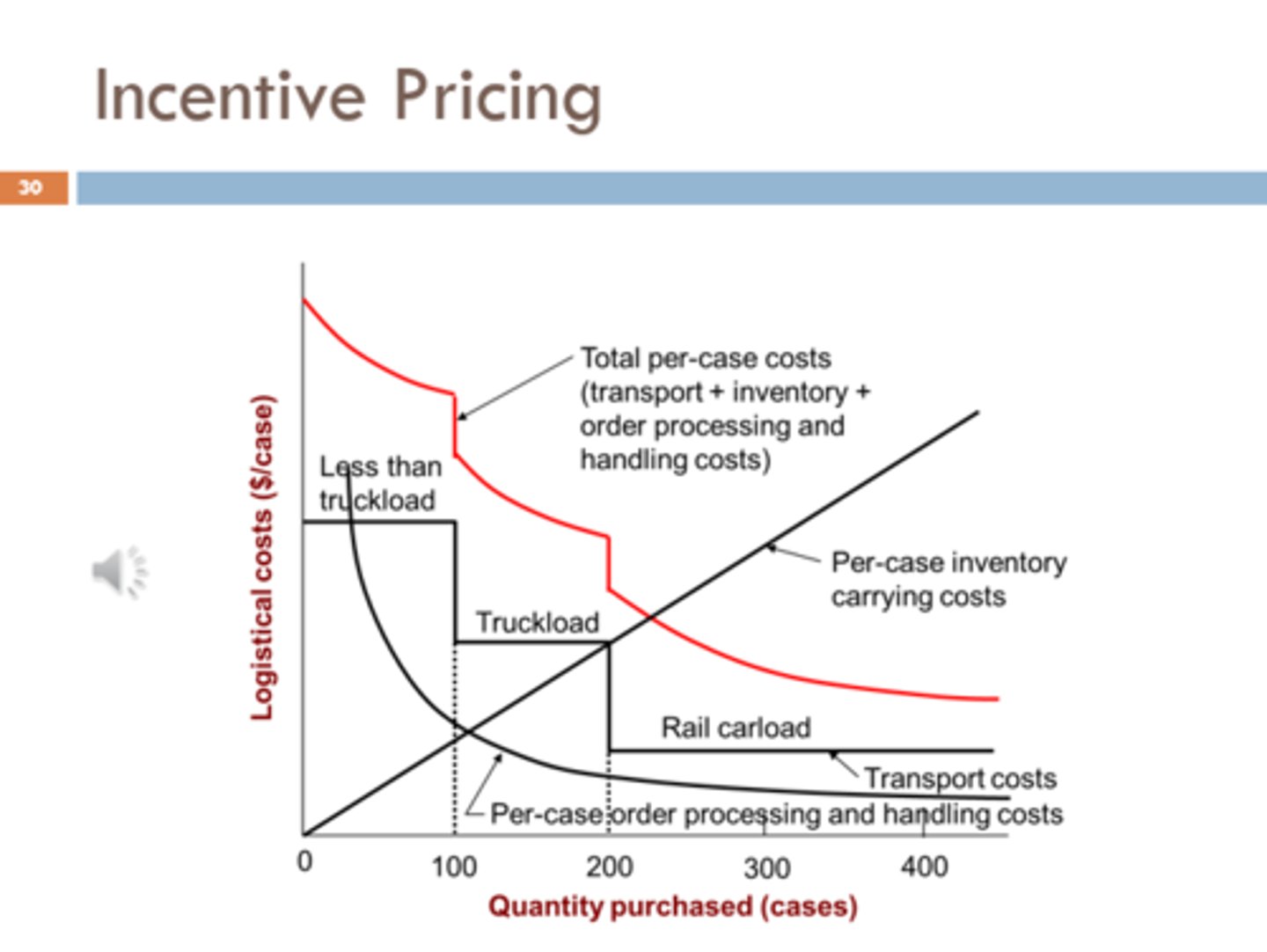
lecture notes 7
intro to transportation:
*transportation involves the physical movement of goods between origin and destination points
*transportation systems link geographically-separated partners, facilities and customers in a company's supply chain
*transportation facilitates the creation of time and place utility in the supply chain
*transportation has a major impact on company financial performance and efficiency and enhances the competitiveness of a supply chain
importance of an effective transportation system:
*greater competition
-opportunities to serve distant markets
*economies of scale
-decoupling of markets and production sites
*reduced prices
-inexpensive transportation, intense competition
challenges in transportation:
*supply chain complexity (more customized solutions for customers, more robust processes, more links in the chain, higher number of products as far as the product mix vs the lower)
*competing goals among supply chain partners (trying to buy from suppliers at the lowest price possible and they want to make the most profit possible, just in time goals, freight consolidation goals)
*changing customer requirements (covid- surge in home delivery demand)
*limited information availability (sparse in third world countries)
*synchronizing transportation with other supply chain activities (challenging to get everything to work correctly)
*capacity and rising rates (capacity constraints during holidays, have to prebook in time ; rising rates in transportation because of shortage of truck drivers)
*government regulations
-including regulations that have the potential to impact the quality of life, the safety of citizens, and the growth of commerce.
-(impacted transportation because some administrations are more relaxed/lenient and others are stringent)
regulations in transportation:
*federal motor carrier safety administration (FMCSA) hours of service (HOS) regulations
-11 hours of driving time within a 14 hour shift, then 10 hours off duty
-30 minute break after 8 hours of driving
*bureau of customs and border protection (CBP) - 24 hour manifest rule
-complete manifest information should be submitted a day in advance
*environmental protection laws
-noise protection
-vehicle emission regulation
-this is where CNG (compressed natural gas) trucks have advantage
safety regulations:
*US department of transportation (DOT)
-responsible for US national transportation policy
-13 administration agencies and bureaus
*examples:
-federal highway administration (FHWA)
-federal motor carrier safety administration (FMCSA)
-compliance, safety, accountability (CSA) initiative
-federal aviation administration (FAA)
-federal railroad administration (FRA)
-maritime administration (MARAD)
-US coast guard (also branch of armed forces)
transport service:
set of performance characteristics purchased at a given price
*performance
-average transit time
-average transit time variability
-loss and damage
-other factors
*price
-line-haul
-terminal/local
-accessorial or special charges
transport choice:
*modes of transportation
-air
-truck
-rail
-water
-pipe
*coordinated services (multimodal)
-piggyback (UPS truck on top of a rail car)
-birdyback (plane)
-fishyback (ocean freight)
*small shipment carriers (150 pounds or less)
-UPS, fedex
-postal services
*agents
-freight forwarders
-shipper associations
*others
-autos
-bicycles
-taxis
-human
-electronic
-drones ?
-driverless trucks ?
modes of transportation:
*the five basic modes of transportation and intermodal transportation each has different economic and technical structures, and each can provide different qualities of link service.
*truck and rail are the most popular modes of transportation
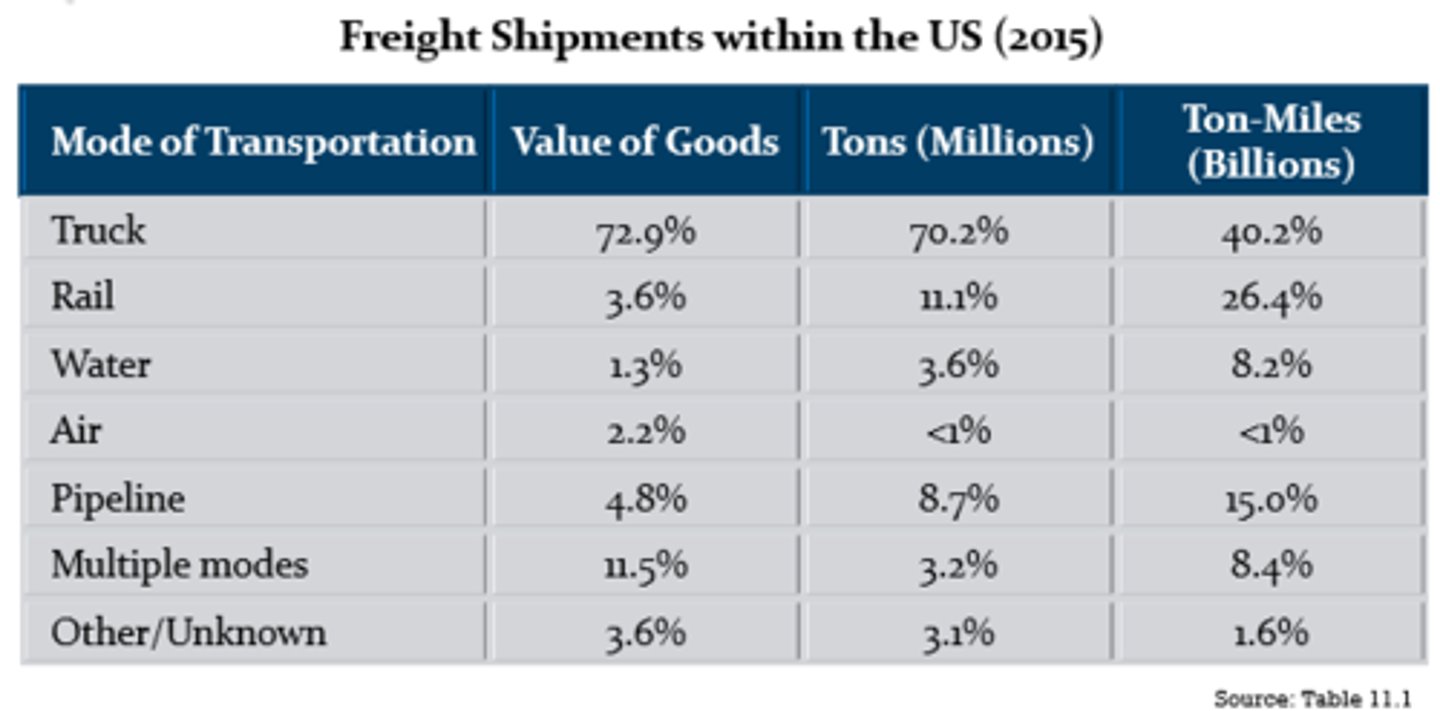
modes of transportation - truck:
*moderately high valued, time sensitive; finished and semi finished products
*point to point service
*flexible and fast
*cost structure: low fixed cost, high variable cost
*sometimes called motor carriers
-widely used mode of transportation in the domestic supply chain
-economic structure of the motor carrier industry contributes to the vast number of carriers in the industry
-comprised of for hire and private fleet operations
-truckload carriers: greater than 15,000 lbs
-less than truckload (LTL): from 150 to 15,000 lbs
-small package carriers: less than 150 lbs
motor carrier equipment options:
LCV = longer combination vehicle
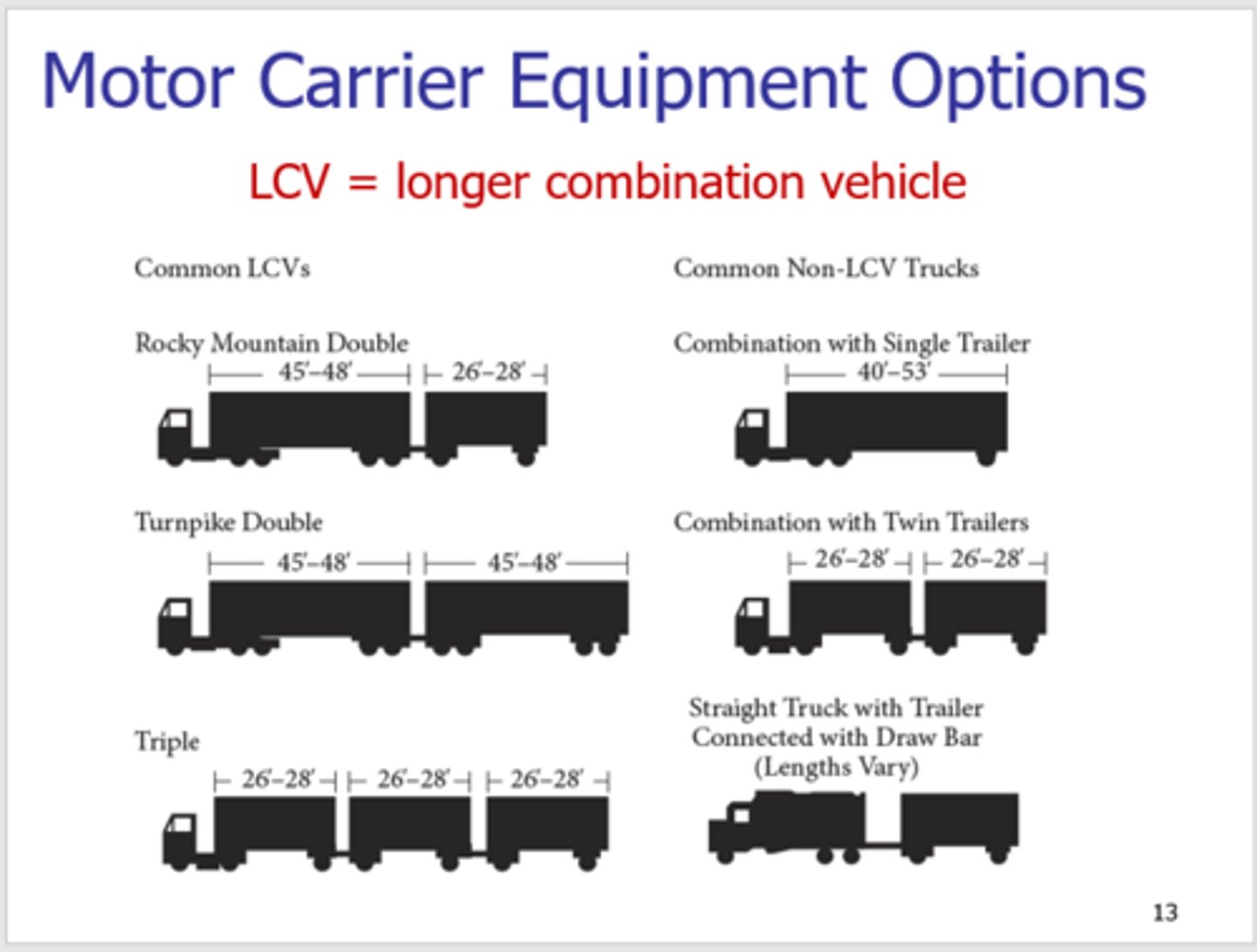
modes of transportation - rail:
*mass movement of low valued goods
*large capabilities
*cost structure: high fixed cost and low variable cost
*railroads are "natural monopolies"
*seven class I railroads in the US
-burlington northern santa fe railway
-CSX transportation
-grand trunk corporation
-kansas city southern railway
-norfolk southern combined railroad subsidiaries
-soo line corporation
-union pacific railroad
*two carrier types:
-linehaul freight carriers
-shortline carriers
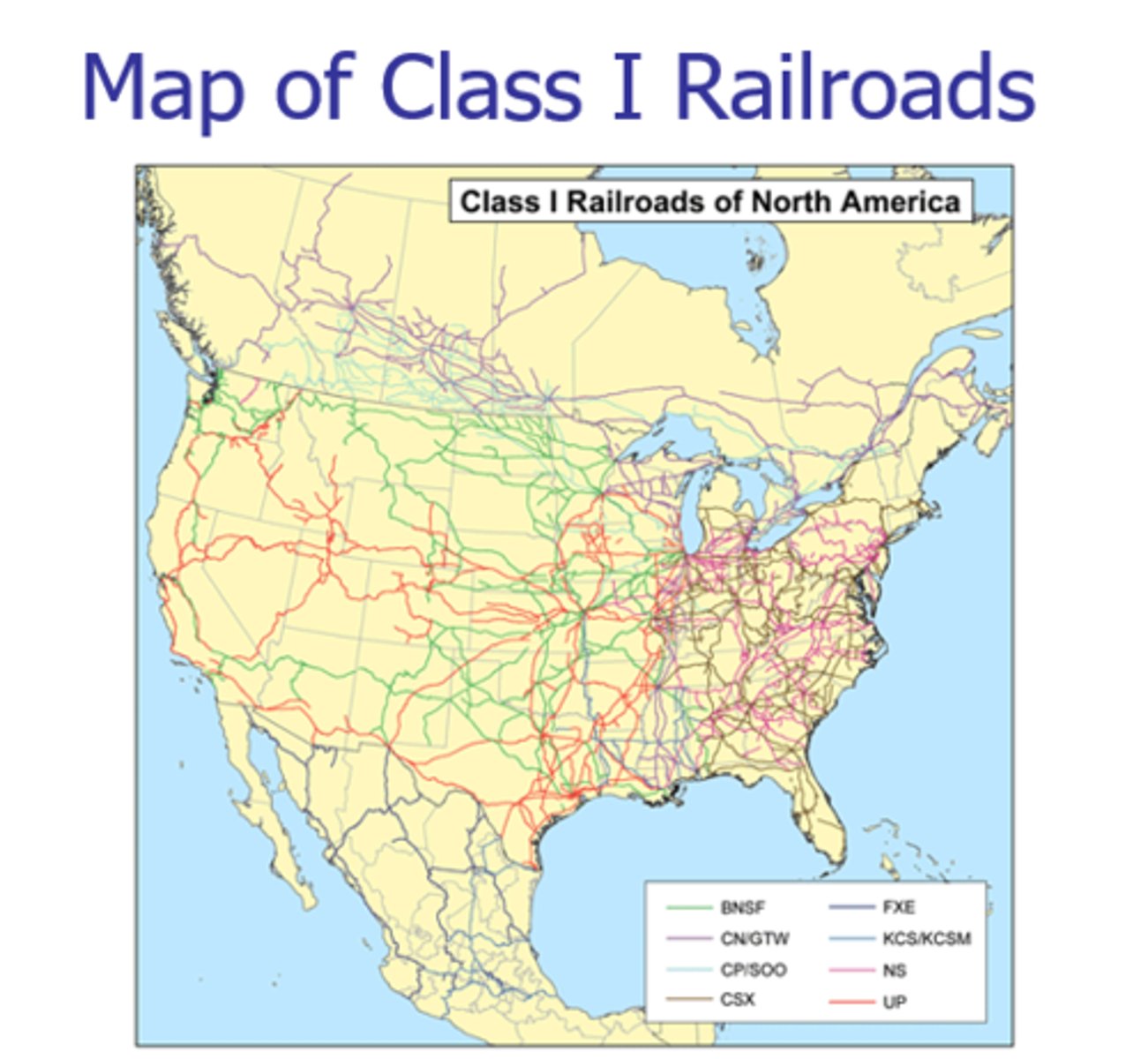
modes of transportation - air:
*high valued, time sensitive products
*high variable cost relative to fixed cost
*fastest for long distances
*broad service range
*88 air cargo carriers (22 major ones)
-combination carriers
-air cargo carriers
-integrated carriers
-nonintegrated carriers
modes of transportation - water:
*lowest costs and large capabilities
*major facilitator of international trade
*international freight movement
*domestic coastal, inland, and great lakes traffic
*mass movement of bulk commodities
-low valued (domestic shipment)
-high valued (international shipment)
*high terminal costs and low line haul cost
*cost effectively moves large quantities
-petroleum, coal, iron ore, chemicals, etc
*two primary carrier types
-liner
-charter
*options include:
-container ships
-bulk carriers
-tankers
-general cargo ships
-roll on, roll off (RO-RO) vessels
modes of transportation- pipeline:
*equipment fixed in place; product moves through in high volume
*mass movement of liquid and gasses
*lowest operating cost and unit costs
*high fixed cost and low unit costs
performance overview:
*air is generally fast over long distances
*water is slow and moderately reliable
*truck is moderately fast and reliable
*rail is slower and less reliable than truck
intermodal transportation:
*use of two or more different modes in movement
*greater accessibility and overall cost efficiency
*facilitates global trade
*development of standardized containers that are compatible with multiple modes
*containerized freight
-hauls only the container
-eliminates the dead weight of understructure
-standardized containers allow flexibility
-air truck
-water truck
*transload freight
intermodal services:
*can have more than two modes
*rail and truck (piggyback)
*rail and water
*rail and air
*rail and pipeline
*truck and water (fishyback)
*truck and air (birdyback)
*truck and pipeline
*water and pipeline
*water and air
*air and pipeline
intermodal services -- trailer on flatcar (TOFC):
*also called "piggyback"
-truck trailers on railroad flat cars
*advantages:
-convenience and flexibility from trucking
-long haul economy from rail
-longer distances than trucks normally haul
*TOFC offered in five different plans based on:
-ownership of the highway and rail equipment
-rate structure established
intermodal services -- containerized freight:
*hauls only the container
-eliminates the dead weight of understructure and wheels of a trailer
*standardized containers allow flexibility
-air truck
-water truck
who owns?
*company controlled transportation
-expected benefits
-better operating performance
-greater availability
-higher transportation capacity
-lower cost
-downside
-high volume needed to justify investment
*outsourced
-3pl
-partial leases
agencies and small shipment services:
*agents
-air and surface forwarders
-shippers' associations
-transport brokers
*small shipment services
-US postal service, UPS, fedex, etc
-limited in size and weight
transport management planning activities:
*which department will be responsible for transportation?
-logistics
-procurement
-marketing
*terms of sale
-free on board (FOB) origin
-FOB destination
*decision to outsource transportation
-firms choose to "make" or "buy"
*modal selection
-accessibility
-advantage: motor carriage
-disadvantage: air, rail, and water
-transit time
-advantage: air and motor carriage
-disadvantage: rail, water, and pipeline
-reliability
-advantage: motor carriers and air carriers
-disadvantage: water carriers and rail carriers
-product safety
-advantage: air transportation and motor carriage
-disadvantage: rail and water
-cost
-advantage: the cost of transportation service varies greatly between and within the modes
-disadvantage: motor carriage and air transportation
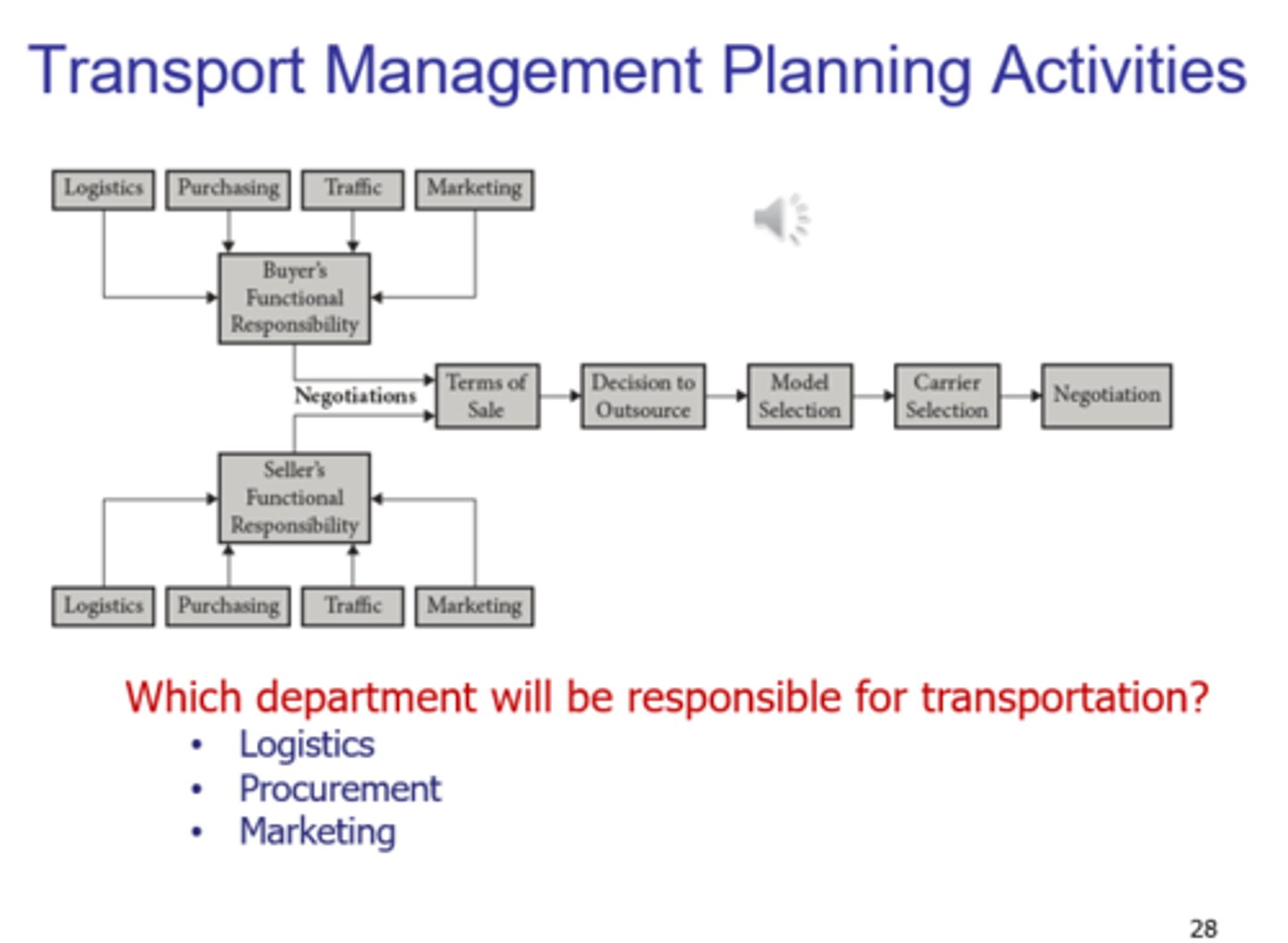
transportation planning and strategy:
modal selection- capabilities, product characteristics and pricing
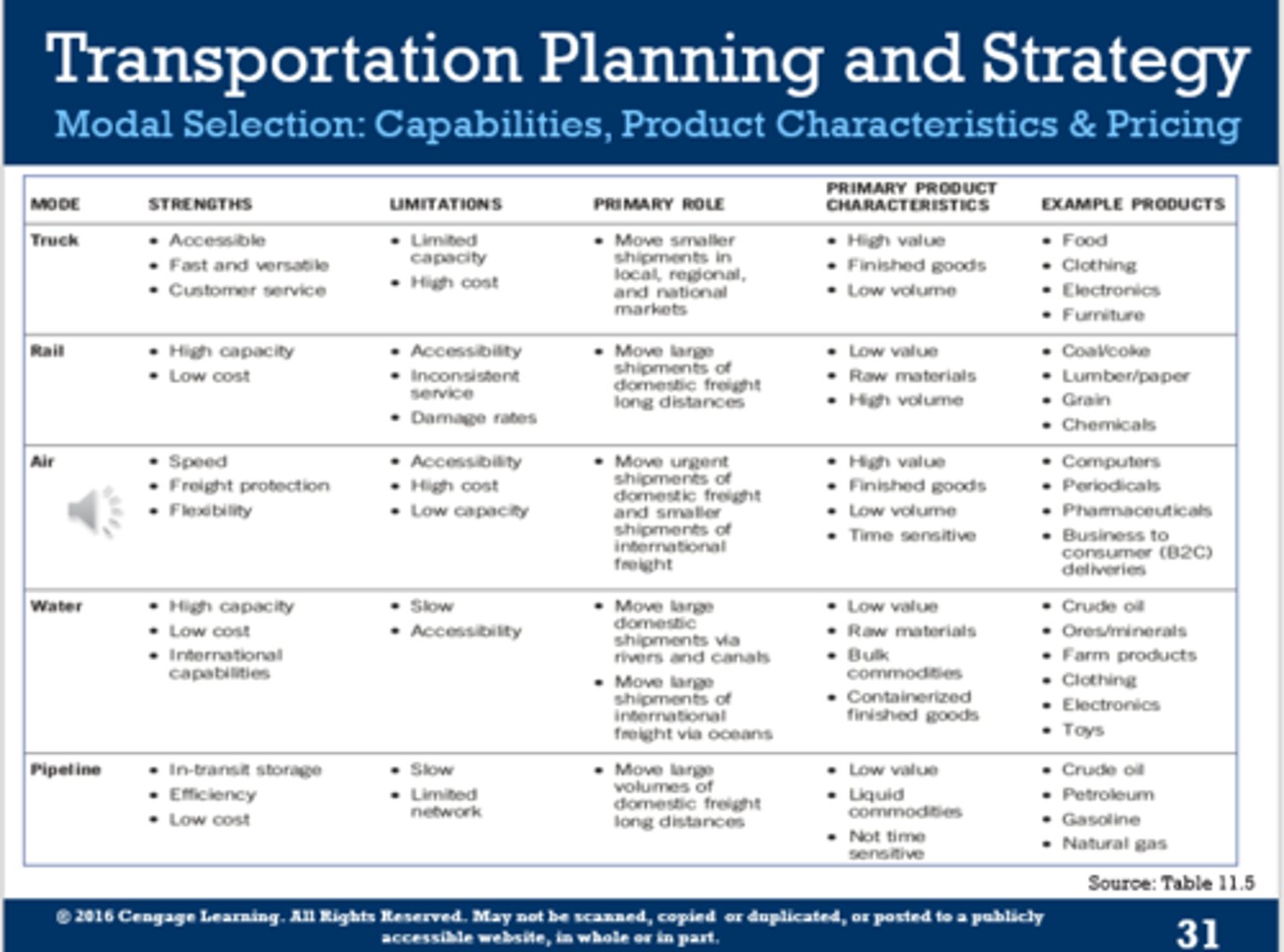
transportation planning and strategy pt 2:
modal selection- performance ratings of modes
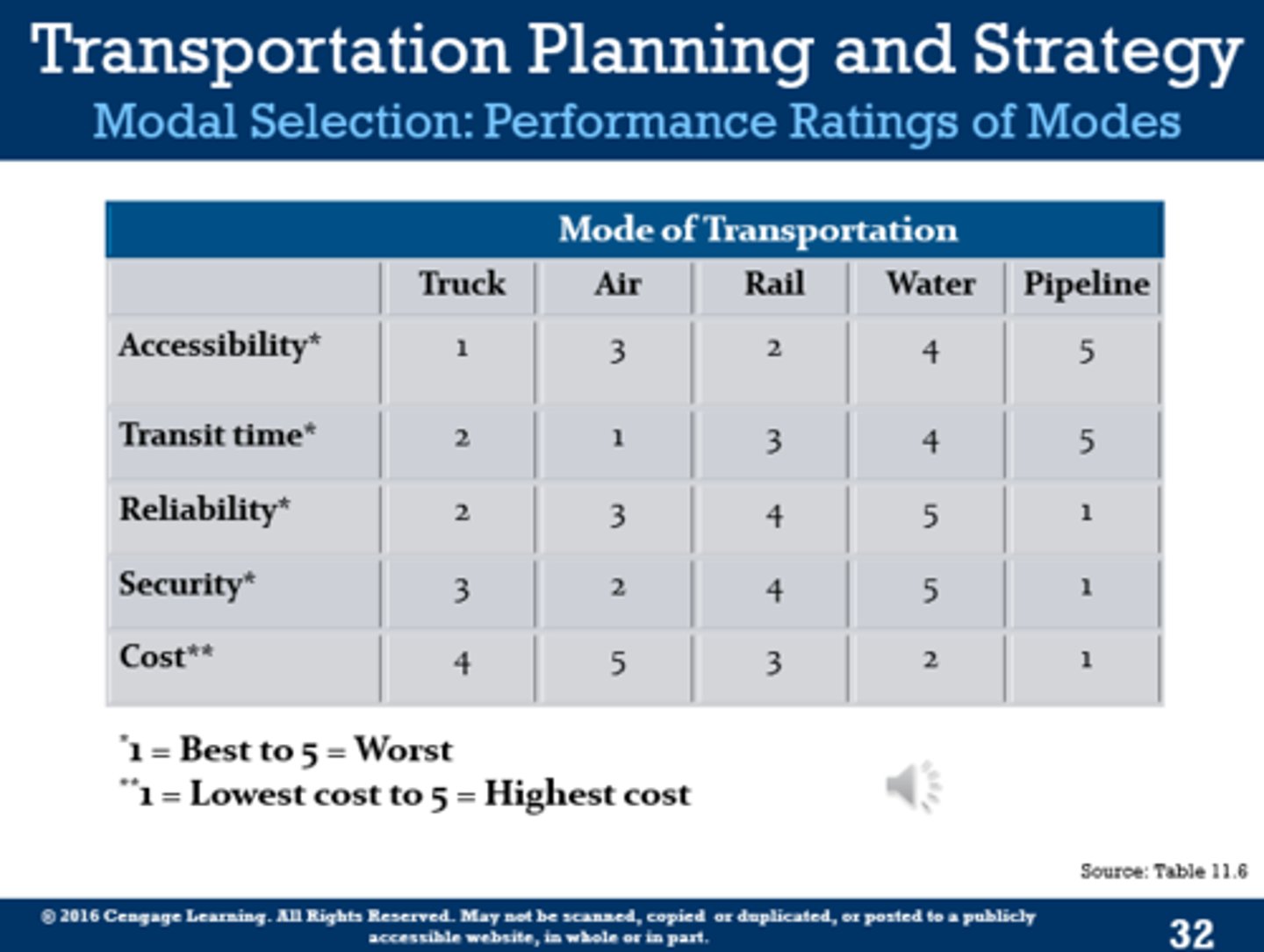
transport management planning activities pt 3:
*carrier selection
-selecting the individual transportation service providers within the mode
-major difference between modal and carrier selection is the number of options and decision frequency
-type of service provided within a mode impacts carrier selection
-most carriers have the capabilities to provide a similar level of service
*rate negotiations
-centralized freight rate negotiations
-developing contracts with carriers for a tailored set of transportation services at a specific price
-leveraging volume with a small set of carriers
freight documentation:
*bill of lading
-originates the shipment
-provides all the information the carrier needs
-stipulates the contract terms, including carrier's liability for loss and damage
-acts as a receipt for the goods the shipper tenders to the carrier
-in some cases, shows certificate of title to the goods
*freight bill
-carrier's invoice for the carrier charges listing
-shipment
-origin and destination
-cosignee
-items
-total weight
-total charges
*freight claims form
-loss, damage and delay claims
-overcharges
transportation management system (TMS)
*critical applications include the following:
-routing and scheduling
-proper planning of delivery routes has a major impact on customer satisfaction, supply chain performance and organizational success
*load planning
-effective preparation of safe, efficient deliveries
*load tendering
*status tracking
*appointment scheduling
transportation metrics:
*ensures service quality
*need to maintain in-transit visibility
-security
-integrity of shipment
*key performance indicators (KPIs) can be used to evaluate:
-current performance vs historical results
-internal goals
-carrier commitments
*challenge lies in narrowing down metrics available to monitor performance to a manageable number of KPIs
*primary categories include service quality and effiency
example of transportation metrics:
chart that helps identify deficiencies.

rail:
*lower frictional resistance than vehicles on roads
*powered by locomotives, electric or diesel
*railways safer than other forms of land transportation
*1830 - US baltimore and ohio railway
*1850-1890 - tremendous growth in US rail system
*railway on land owned or leased by company
US interstate highway system:
*dwight d eisenhower national system of interstate and defense highways
*federal aid highway act of 1956
*original portion completed 1991
*cost $425 billion
*47,182 miles as of 2010, second to china
US trucking industry:
*USDOT - US department of transportation (trucking, rail, shipping, airlines)
*FMSCA - federal motor carrier safety administration
*FHWA - federal highway administration
*EPA - environmental protection agency
*9 million employed in truck-related jobs
*15 million trucks operate in the US
*70% of US freight transported by truck annually
*$671 billion worth of manufactured and retail goods
international transportation:
*mode of transportation
-depends on the geography and proximity of the partners
-water: major transportation mode
-air: second important
-truck, rail, and pipeline, etc
*issues in international transportation
-more paperwork
-limited number of routes
-expensive (additional packaging, increased shipment, etc)
international transportation "foreign trade zones":
*potential advantages
-process and reship to another country
-no customs payment until the entry to the importing country's customer zone
-no duties on product deterioration
-ship unassembled and assembled in the zone
-capital flexibility
-privileged foreign trade status for importers
-duties applied only on the parts imported
transport cost characteristics:
*variable costs
-vary with service or volume
-ex: fuel, labor, handling, pickup, etc
*fixed costs
-constant, not dependent on service or volume
-ex: terminal facilities, transport equipment, carrier administration
*common or joint costs
-cost allocations between shipments
rate profiles:
*volume-related rates
-minimum or any quantity (aq) charge for low volume
-less than vehicle load for shipment larger than minimum quantity and less than full vehicle load ( > min, but < full load)
-full vehicle load: high volumes
*distance related rates
-uniform rates (us postage rates)
-proportional rates
-tapering rates
-blanket rates
*demand related rates
transport prices:
*line haul rates
-by product
-by shipment size
-by route
-miscellaneous rates
*special service charges
-special line haul services
-terminal services
line haul rates by product:
*class rates
-function of distance between origin and destination and other factors
- break weight = (rate (next) * weight (next)) / rate (current)
*contract rates
-blanket rates
*freight all kinds
freight class rate example:
suppose we wish to ship 15,000 lbs. (150 cwt.) of wheat flour from new york to los angeles by truck. The trucker offers a 40% discount from the published tariff. what is the transportation charge?
*from the freight classification table, item number = 1090--00
*minimum weight = 36,000 lbs
*shipment = 15,000 lbs < 36,000 lbs, therefore it is LTL and the class rating is 55
*rate is 6,065 or $60.65 per cwt. from class 100 tariff
*with a 40% discount, the effective rate is (1 - .40) x 60.65 = $36.39
*the shipment charges are (0.55 x 36.39 x 150) = $3,002.18
*(should always check to see if shipment can be declared at the next higher weight break for a lower rate and lower total charges)
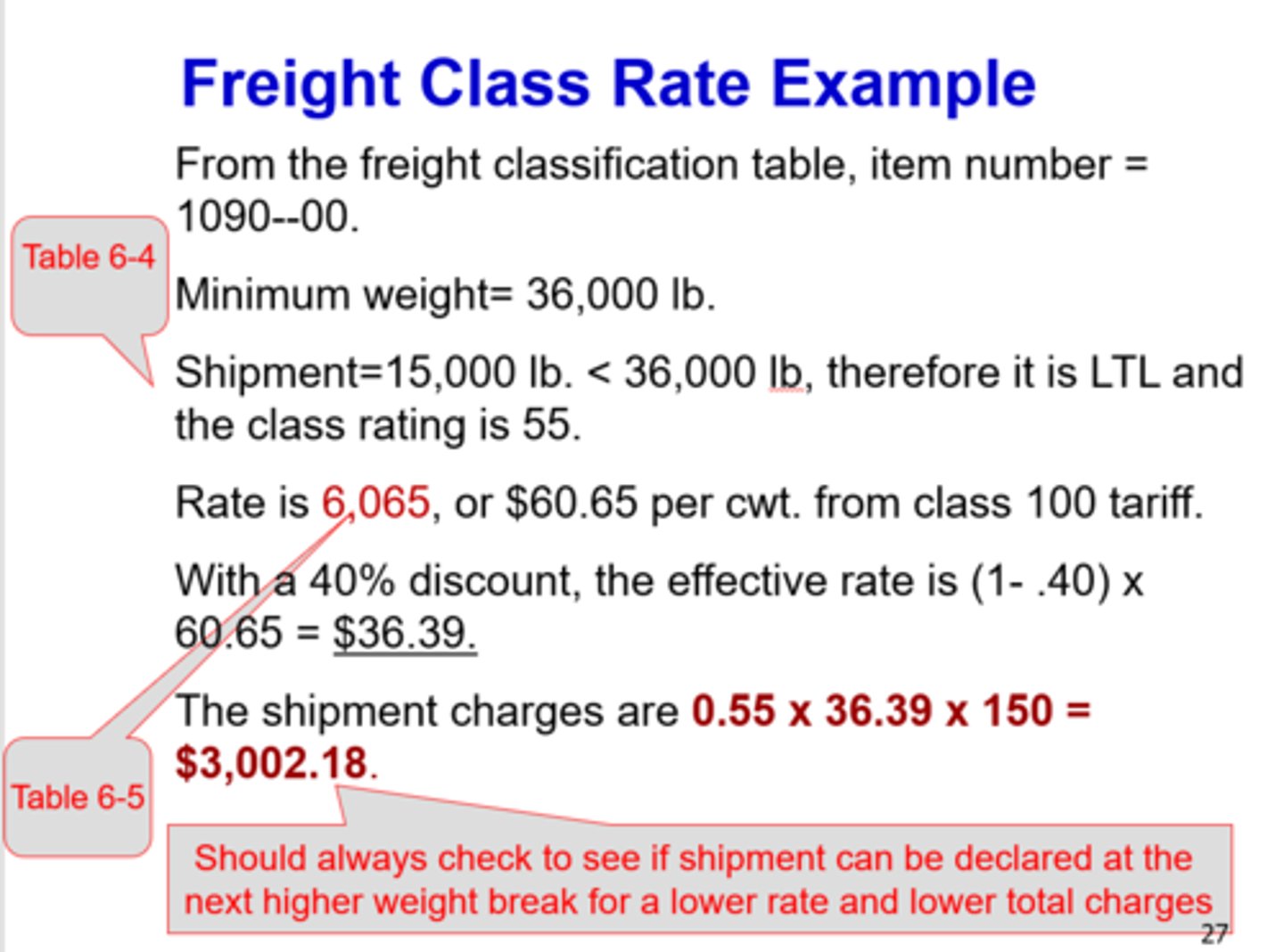
line haul rates by shipment size:
*rates quoted on a dollar per hundred pound (cwt) basis
*rate quoted on minimum quantities, such as 5,000, 10,000, or etc
*any single rate on all quantities (aq)
*other incentive rates
transportation charges based on shipment size:
suppose an item is rated at class 60, has a shipping weight of 1,000 lbs. (10 cwt.), and is to move from louisville, kentucky to chicago, illinois. what is the transportation charge?
*from the selected class truck rates in $ per cwt by classification number and weight break quantity in pounds from louisville, kentucky to chicago, illinois,
rate is $20.43 per cwt. from class 60 tariff.
*the shipment charges are $20.43/cwt x 10 cwt = $204.3.
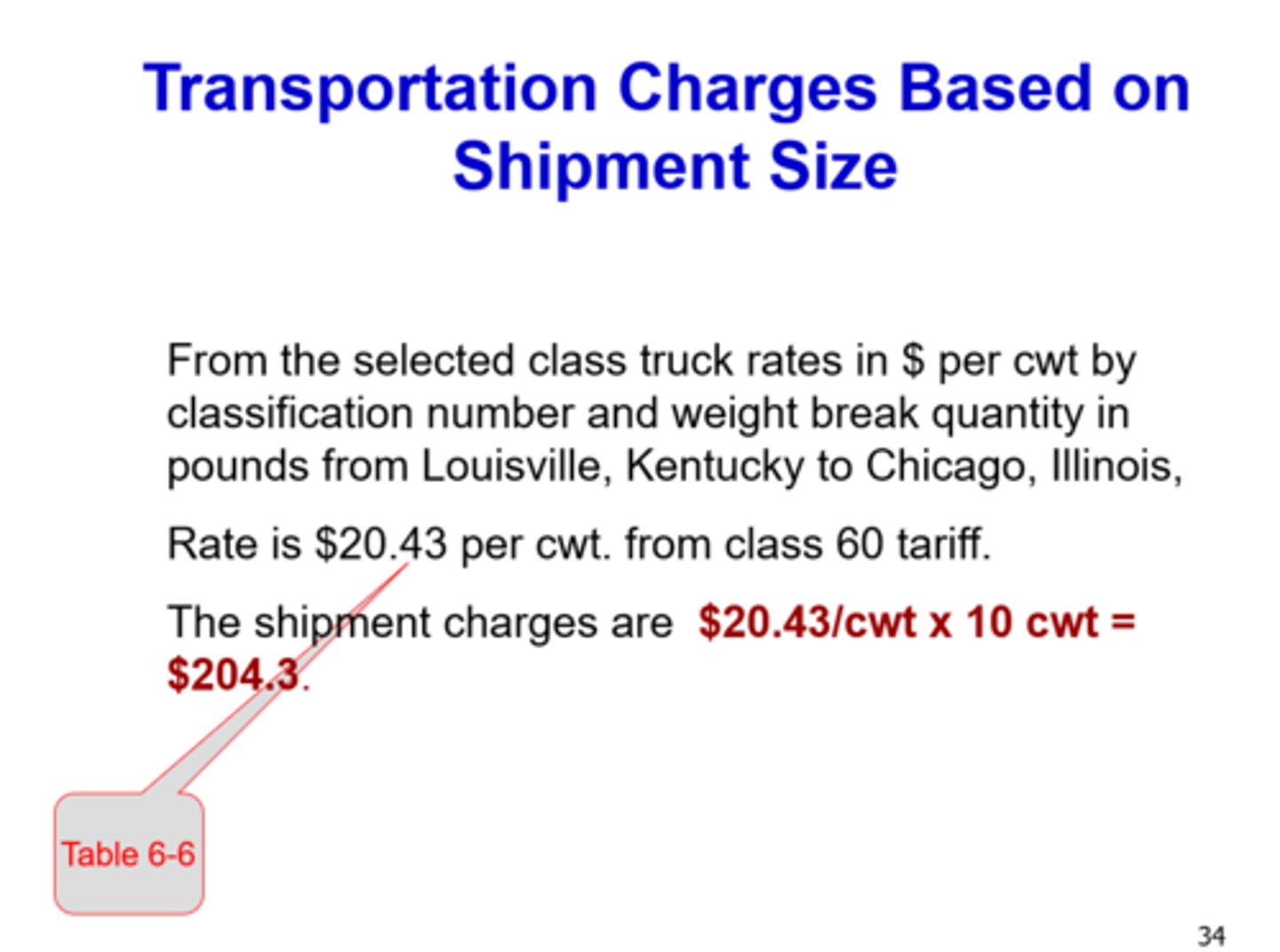
line haul rates by route:
for full vehicle load movements, a per mile charge + a stop-off charge is added if there is more than one stop
*example: a truck shipment of 42,000 lbs. originates at atlanta, ga and makes three stops for delivery at dallas, texas, oklahoma city, oklahoma and st.louis, missouri. a stop-off charge of $75 per stop is assessed. the distance from atlanta to dallas is 822 miles, from dallas to oklahoma city is 209 miles and from oklahoma city to st. louis is 500 miles. per mile-cost at st. louis is $1.65. what is the cost of the trip?
*(822 + 209 + 500) x 1.65 = $2,526.15 mileage
*(3 stops x $75) = $225 stop off charge
*total transport cost ($2,526.15 + $225) = $2,751.15
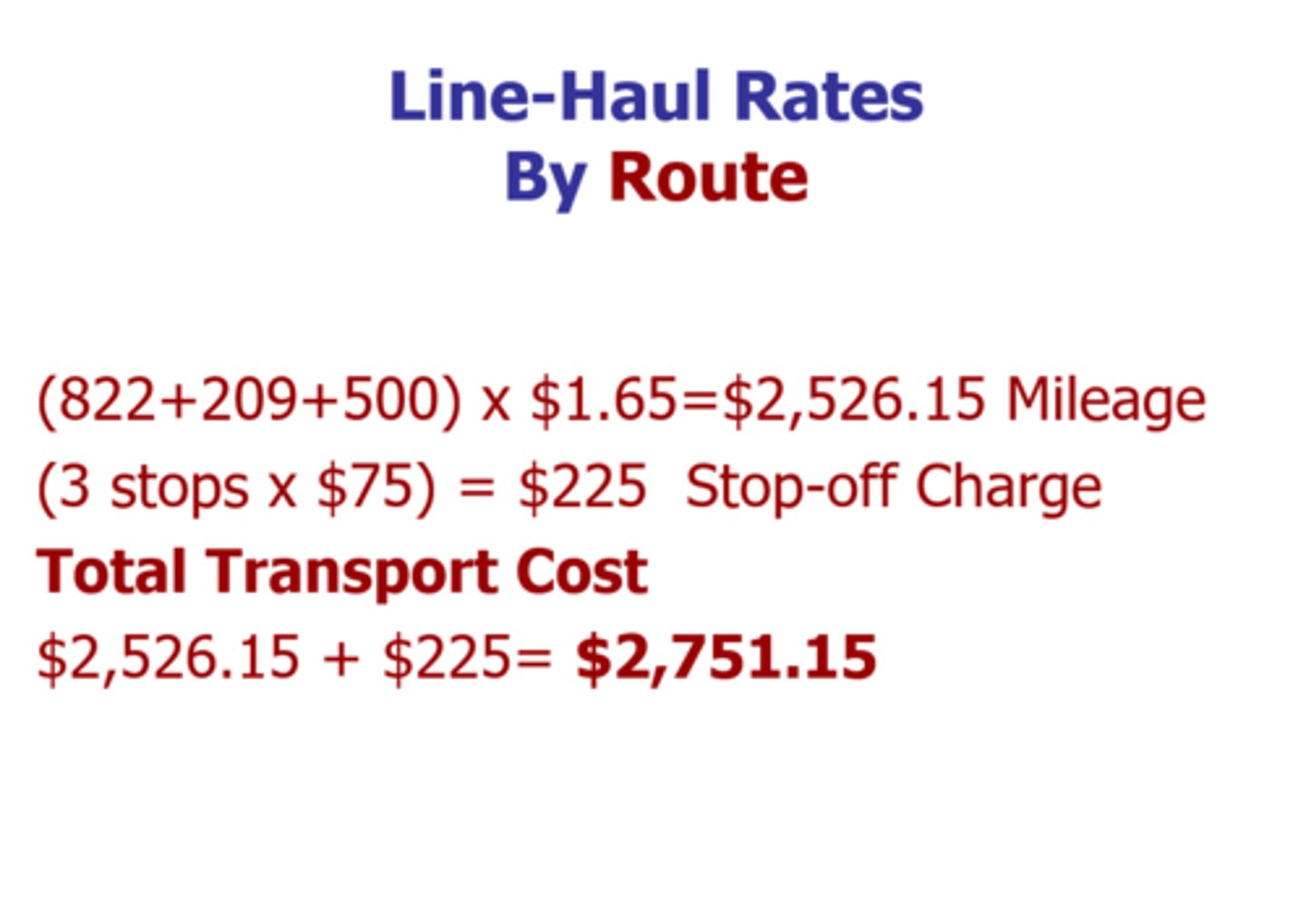
line haul rates - miscellaneous:
*cube rates
*import - export rates
*deferred rates
*released value rates
*ocean freight rates
special service charges:
*special line haul services
-diversion and reconsignment
-transit privileges
-stop off to complete loading
-stop off to partially unload
-protection
-interlining
*terminal services
-pickup and delivery
-switching
-demurrage and detention
stop off privilege example pt 1:
suppose 3 shipments of J=8,000 lbs., K=12,000 lbs., and L=10,000 lbs. originating at I are to be delivered in the following way. what are the differences in freight charges with and without a stop-off privilege?
*I -> J for 8,000 lbs, it is $3.05/cwt
*I --> K for 12,000 lbs, it is $3.35/cwt
*I --->L for 10,000 lbs, it is $3.60/cwt ; for 30,000 lbs, it is $3.00/cwt
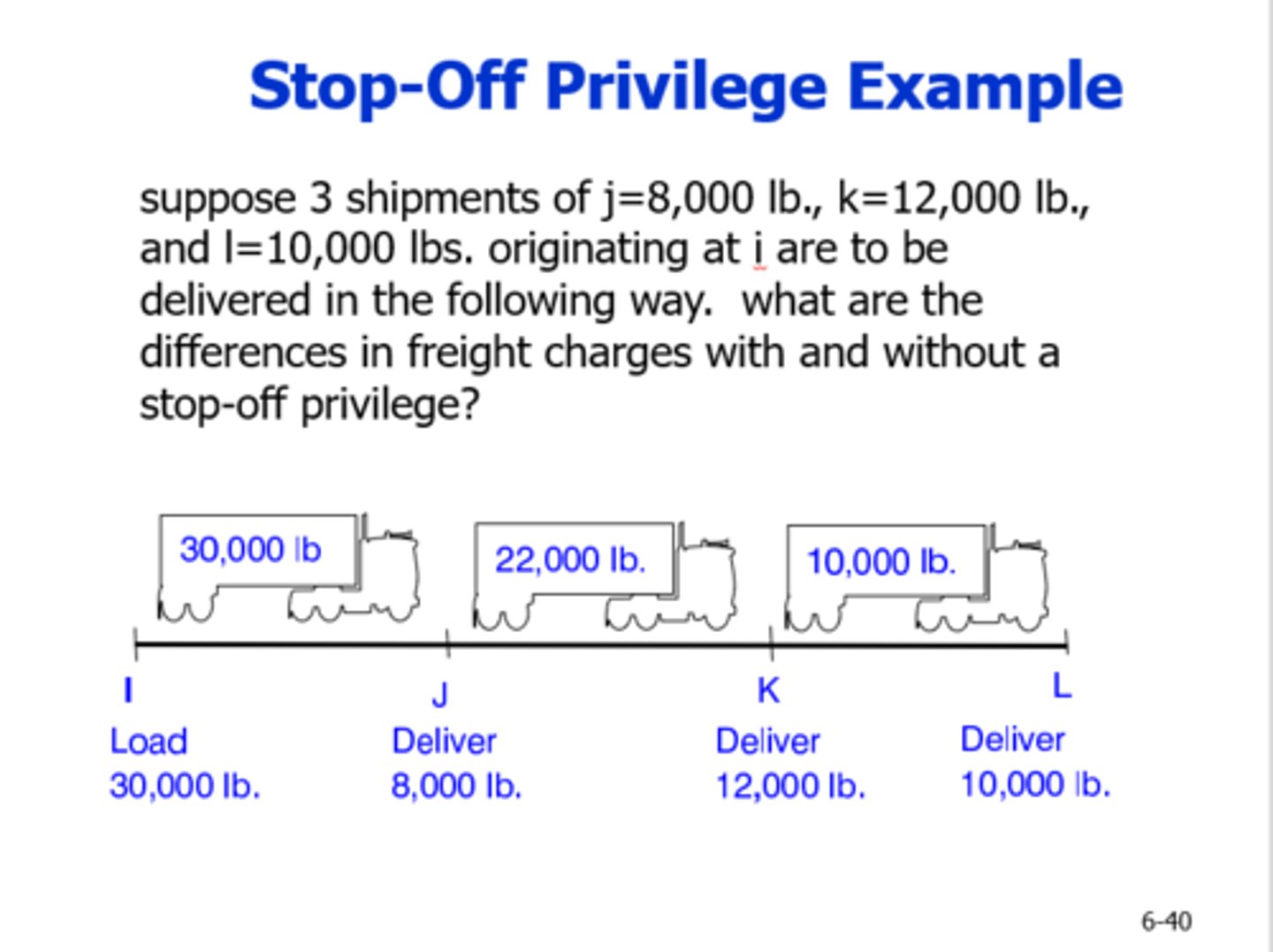
stop off privilege example pt 2:
*first, we compare the costs without the stop-off privilege. this would be to price as if each shipment is a separate shipment from I. suppose we know the rates.
loads (8,000 + 12,000 + 10,000) = 30,000 lbs
charges ($244 + $402 + $360) = $1,006
*now, we price with the stop-off privilege. we assume that all the volume (30,000 lbs.) is to be delivered to the farthest stop and we use the rate to that point ($3.00/cwt.). a small stop off charge of $15.00 is made for each stop including the last stop.
rate $/cwt = 3.00
3 stops = $15 =
$15 * 3 = $45
30,000 * .03 = $900
charges = ($900 + $45) = $945
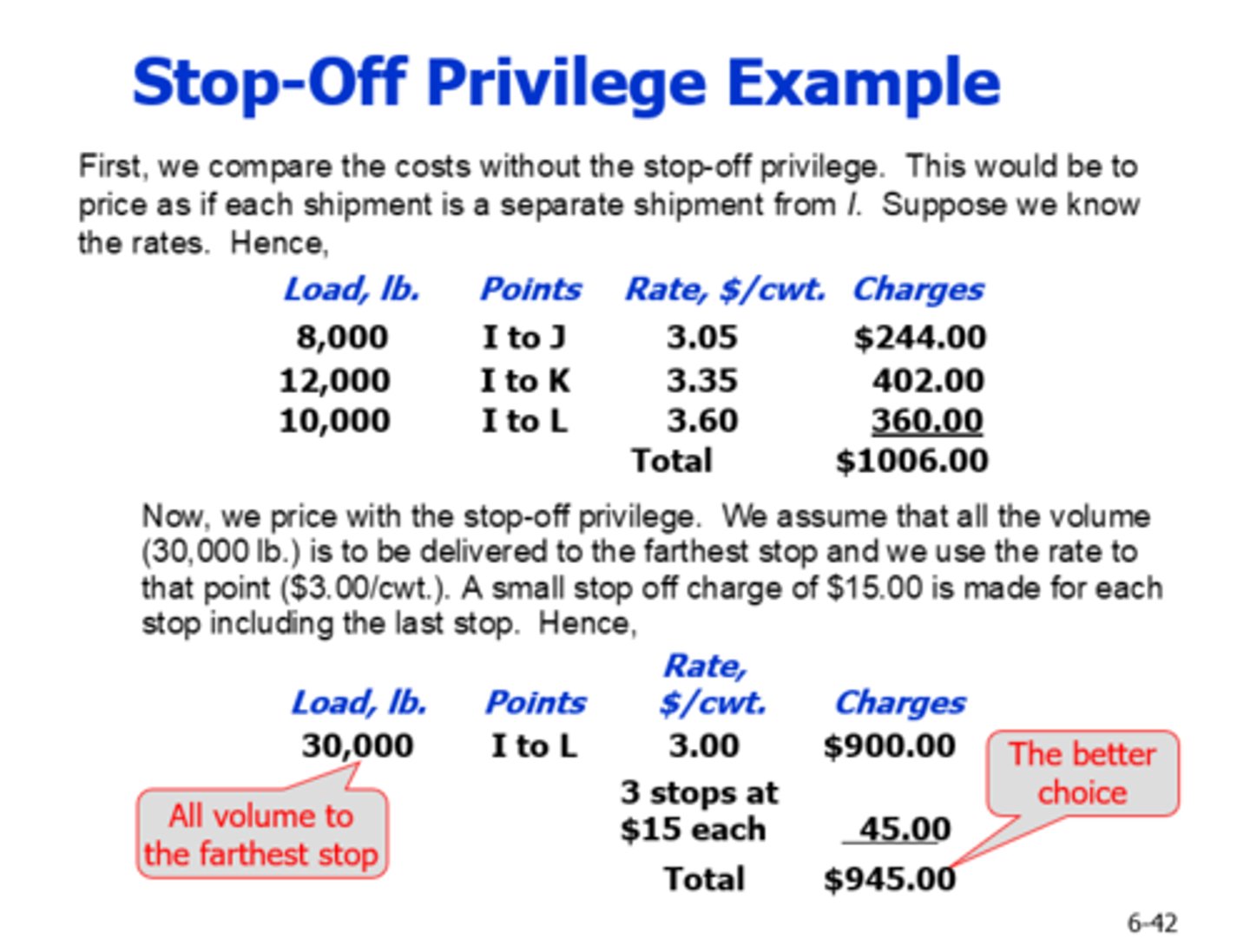
break weight:
break weight = (rate (next) * weight (next)) /rate (current)
break weight= weight above which the next higher weight break rate should be used for lower transport costs
rate (next)= rate for next higher weight break
weight (next)= minimum weight of next higher weight break
rate (current)= rate for true weight of shipment
national motor freight classification:
*a standard that provides a comparison of commodities moving in interstate, intrastate, and foreign commerce
*commodities are grouped into one of 18 classes—from a low of class 50 to a high of class 500—based on an evaluation of four transportation characteristics:
-density
-stowability
-handling
-liability
*the NMFC specifies minimum packaging requirements to ensure that goods are adequately protected in the motor carrier environment and can be handled and stowed in a manner that is reasonably safe and practicable.
USDOT agencies:
*OST - office of the secretary of transportation
*FAA - federal aviation administration
*FHWA - federal highway administration
*FMCSA - federal motor carrier safety administration
*FRA - federal railroad administration
*FTA - federal transit administration
*MARAD - maritime administration
*NHTSA - national highway traffic safety administration
*OIG - office of inspector general
*PHMSA - pipeline and hazardous material safety administration
*RITA - research and innovative technology administration
*SLSDC - saint lawrence seaway development corporation
*STB - surface transportation board
break weight example:
suppose 9,000 lbs. of class 100 merchandise is to be shipped from new york to dallas. from table 6-5, the rate would be $52.21/cwt. however, should the shipment be priced at the next higher weight break rate of $40.11/cwt. for a lower cost?
break weight = (rate (next) * weight (next)) /rate (current)
break weight = (40.11 x 100) / 52.21 = 76.82 or 7,682 lbs
since the 9,000 lb. shipment size exceeds the break weight of 7,682 lbs., size as if a 10,000 lbs., shipment for a total cost of $40.11x 100 = $4,011. otherwise, the shipment would have cost $52.21x90 = $4,699.
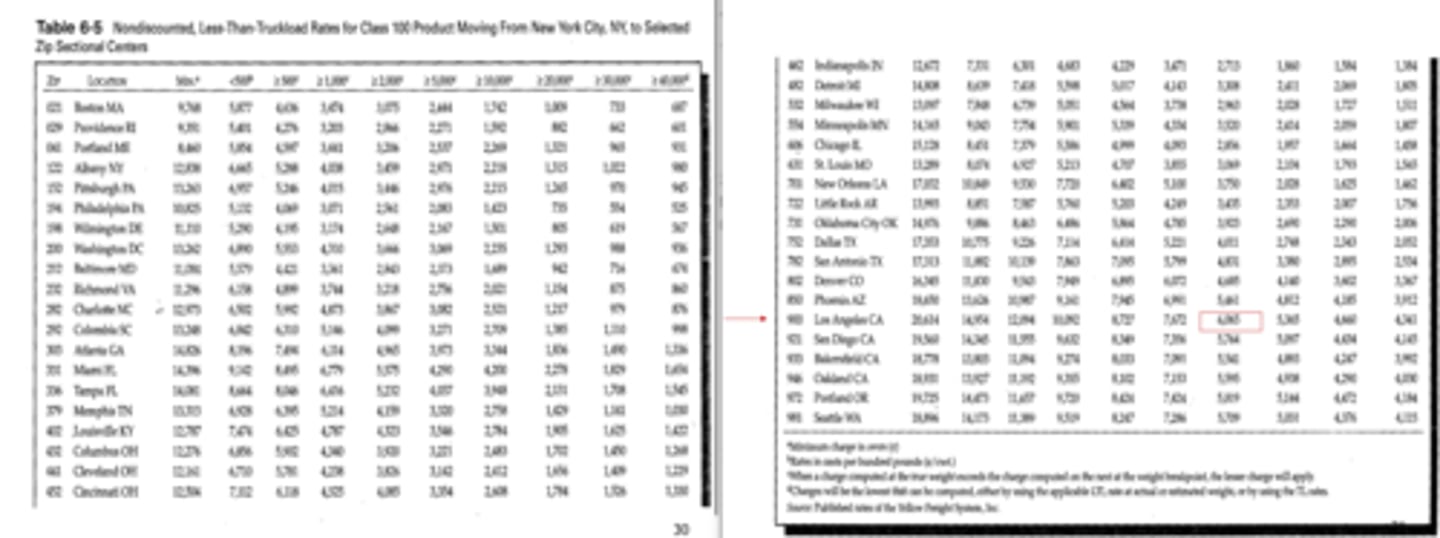
NMFTA:
*the national motor freight traffic association (NMFTA), nonprofit organization consisting of 950 freight carriers.
-NMFTA provides the national motor freight classification (NMFC), a standard that provides a comparison of commodities being transported
-registers standard carrier alpha codes (SCAC) to identify transportation companies
*american national standards institute (ANSI)
-private non-profit organization that oversees the development of voluntary consensus standards for products, services, processes, systems, and personnel in the us.
-ANSI accredits standards that are developed by representatives of standards developing organizations, government agencies, consumer groups, companies
*SCAC for NYK line (nippon yusen kabushiki kaisha), headquartered in tokyo, japan
importance of modes - by volume moved:
*transportation mode & percent of total volume:
-railroads: 36.5%
-trucks: 24.9%
-inland waterways: 16.3%
-oil pipelines: 22%
-air: 0.3%
-total= 100
relative costs of performance:
*mode and price, ¢/ ton - mile
-rail: 2.28
-truck: 26.19
-water: 0.74
-pipeline: 1.46
-air: 61.20
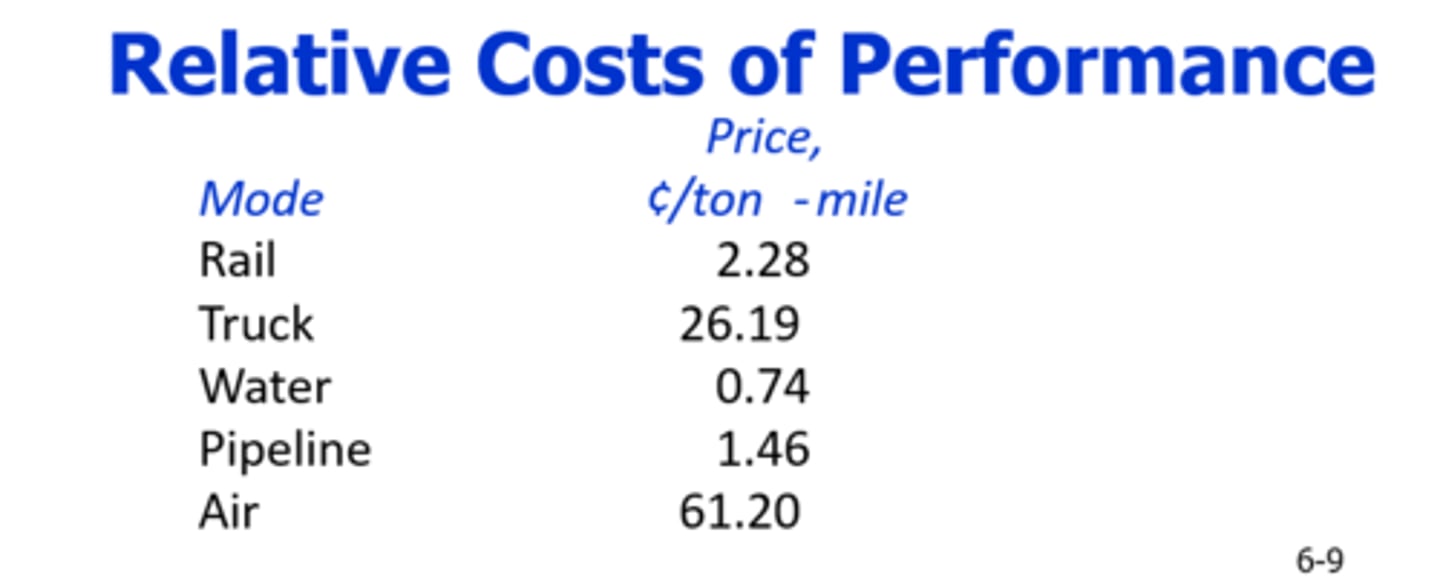
lecture notes 8
supply chains in a global economy:
*companies and entire economies could improve their "wealth" by allowing specialization of tasks
-the assembly line
-economies of scale in production
*the advantage is true as long as you can sell the increased volume of production
-role of logistics: to help extend the market area of companies/countries through improved efficiency
top US trading partners:
1. canada
2. china
3. mexico
4. japan
5. germany
6. united kingdom
7. south korea
8. france
9. taiwan
10. brazil
total value ($ billions)
2008 = $2,124
2009 = $1,679
2010 = $2,059

global markets and strategy:
*success in the global marketplace requires developing a cohesive strategy, including:
-product development
-technology
-marketing
-manufacturing
-supply chain management
*global markets and strategy have four important characteristics
-standardization reduces complexity
-global competition reduces the product life cycle
-traditional organizational structures and business models frequently change
-globalization introduces more volatility
supply chain security:
*given the importance of global trade to the united states, a delicate balance exists between security and the efficient flow of global commerce
-more cargo inspections
-more paperwork
-longer time to clear US borders
*customs trade partnership against terrorism (C-TPAT)
-established under US department of homeland security in november 2001
-is a cooperative effort to secure the global supply chain and to facilitate legitimate cargo and conveyance
ports of entry (POE):
*ports are a critical part of global supply chains and a major focus for global security
*america's ports are a vital part of its global commerce
-over $2 trillion in trade value per year passes through US ports
-over $18 billion is collected in industry fees and taxes
busiest US ports:
1. south louisiana (new orleans to baton rouge), LA
2. houston, TX
3. new york, NY/NJ
4. long beach, CA
5. beaumont, TX
port statistics:
*rankings vary by tonnage, number of containers and value of imports/exports
*chinese ports dominate international rankings
*by tonnage:
-in US, no. 1 is port of south louisiana, no. 2 is houston, no. 3 is los angeles/long beach
*by number of containers:
-in US, no. 1 is los angeles/long beach and no. 2 is ny/nj
ports:
*land ports are also POE
*examples
-along US/mexico border
-laredo
-el paso
-otay messa
-along US/canada border
-detroit (mi)
-buffalo (ny)
ports pt 2:
*challenges along POE
-capacity
-security
*affect wait time at the port
-inspection
-storage/warehouse space close to the ports
land port distribution in US-canada border:
*80% of total traffic in 10 ports
*detroit, MI: 26.46%
*buffalo-niagara falls, NY: 16.69%
*port huron, MI: 12.24%
*champlain-rouses pt, NY: 6.08%
*blaine, WA: 5.94%
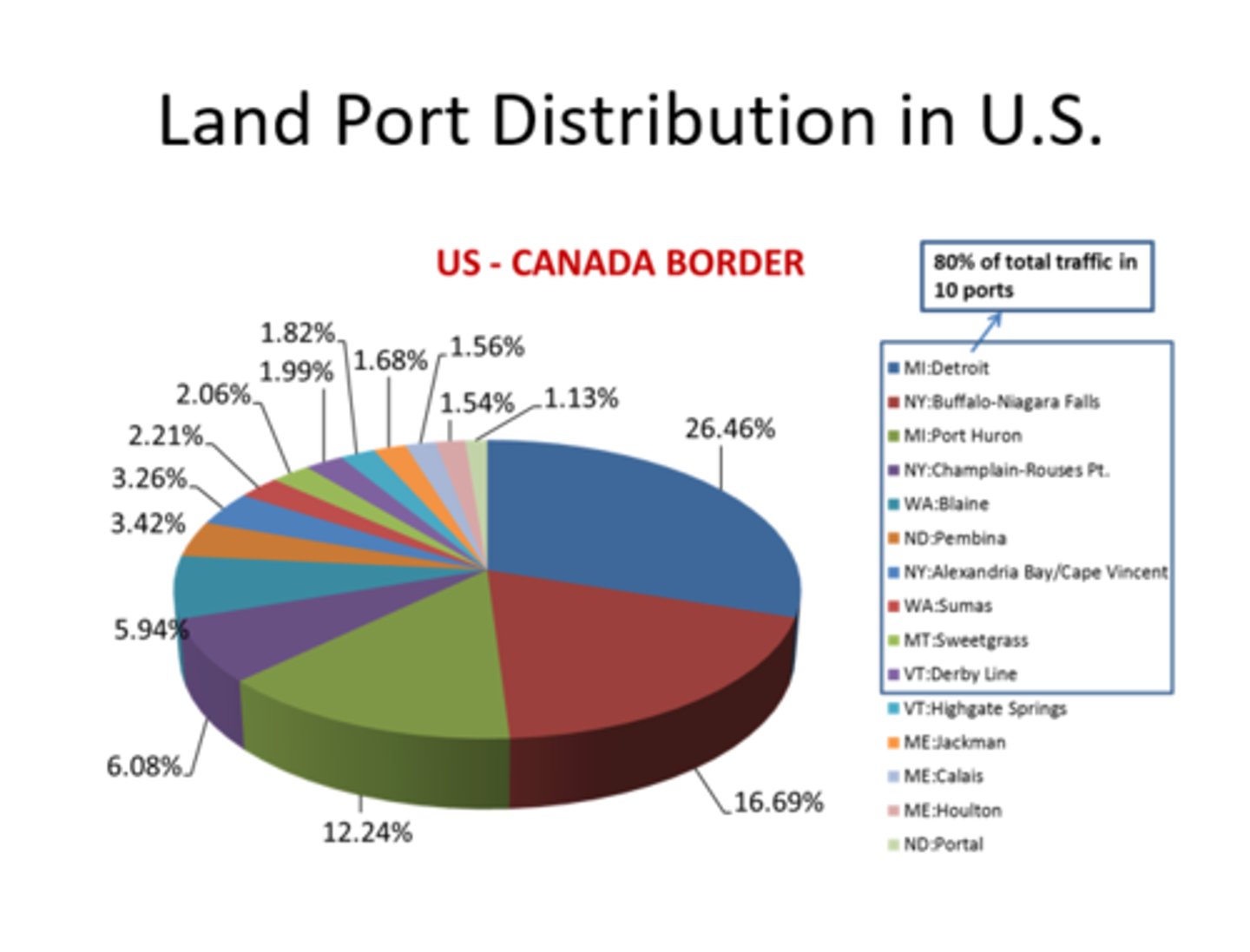
land port distribution in US-mexico border:
*80% of total traffic in 5 ports
*laredo, TX: 31.97%
*el paso, TX: 15.76%
*otay mesa/san ysidro, CA: 15.61%
*hidalgo, TX: 9.79%
*calexico east, CA: 6.59%
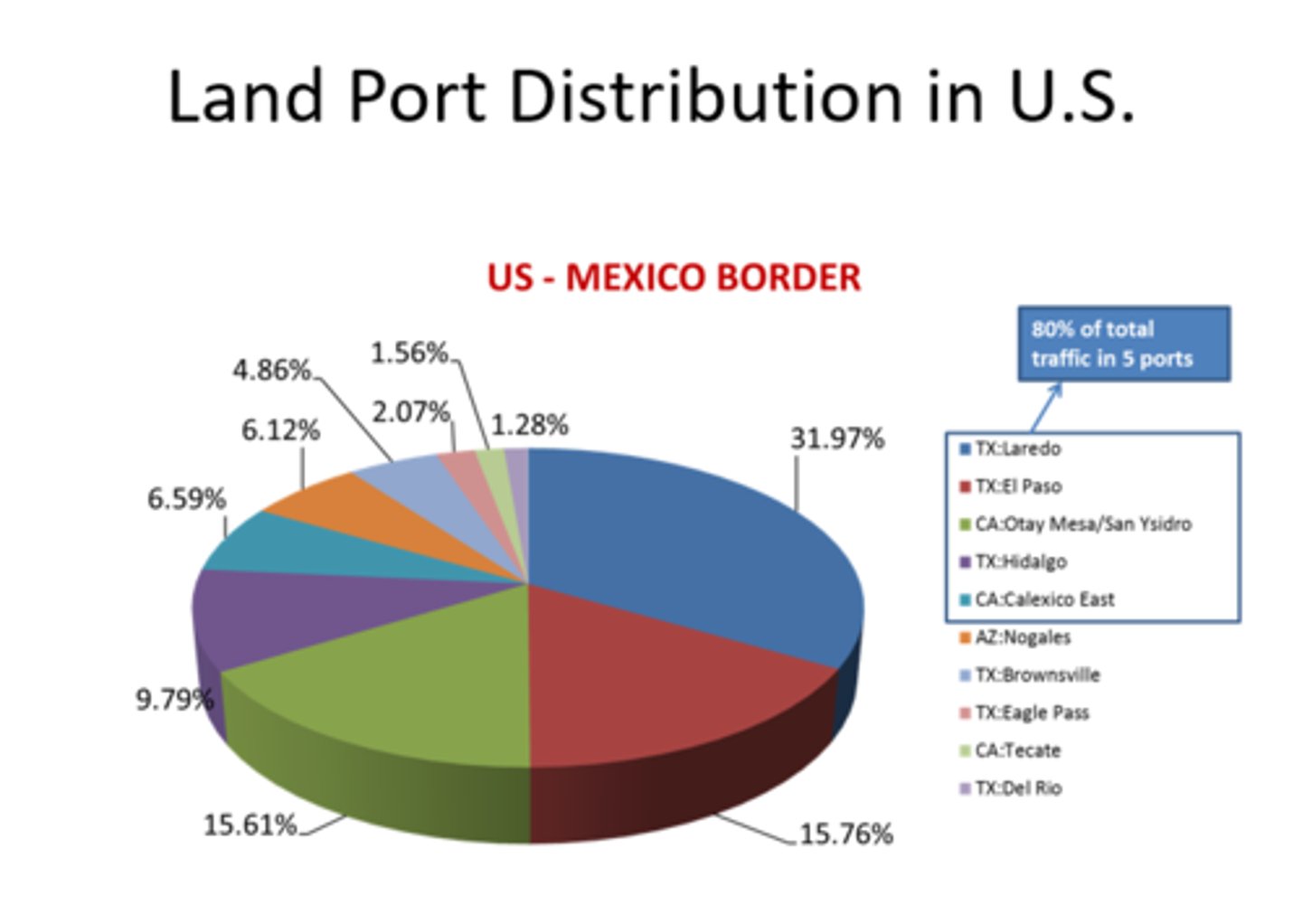
port of houston:
*early history:
-in houston's early days, the shallow draft of buffalo bayou to the foot of main street was used as a port
-larger cargo was still offloaded near galveston
*major factors for creation:
-sept. 1900 - hurricane devastated galveston
-1901 - discovery of oil at spindletop (beaumont)
-increase in exports - crops such as rice and cotton along with oil
*history of the port of houston
-tom henry ball, a local congressman, proposed a plan to fund the port (city of tomball named for him in 1907)
-16-1 vote to approve the port
-jesse h. jones, a politician, persuaded banks to invest (became US secretary of commerce 1940)
-work began in 1912
-completed sept. 7, 1914
*a busy port:
-4th largest port in the US
-busiest US port in terms of foreign tonnage
-2nd busiest US port in terms of overall tonnage
-13th busiest port in the world in terms of overall tonnage
-nation's leading breakbulk post, handling 65% of all major US project cargo (large, heavy, high-value items, pieces of equipment)
*a big impact
-150+ private industrial companies along the 52 mile houston ship channel
-200 million tons of cargo move through the port
-ship channel businesses contribute 1,026,820 jobs throughout TX
-generates $178.5 billion in statewide economic impact and $4.5 billion in state and local tax revenues
*truck vs rail
-ships are routinely turned around in 8-10 days
-landside traffic
-80% shipped by truck
-an average of 1,600 trucks in or out each day
-20% shipped by train
-generally south and central american loads bound for the west coast
*houston handles more than one million TEUs (twenty foot equivalent unit) each year
global transportation options:
*ocean
-the most pervasive and important global shipment method, accounting for 2/3 of all international movement
-major advantages are low rates and the ability to transport a wide variety of product and shipment size
-three major categories:
-liner service
-charter vessels
-private carriers
*air
-fast transit times
-an advantage in packaging
-disadvantage of air carriage is high rates
-belly cargo on passenger flights
*motor
-adjacent countries, e.g. between US-mexico, US-canada, or in between european countries
*rail
-international rail traffic is limited because border crossing points are scarce
-but intermodal movements are increasing. an example (from text)
-japan to europe by sea alone is 28-31 days
-another intermodal route:
-japan to seattle (by sea): 10 days
-seattle to new york: 5 days
-new york to europe (by sea): 7 days
-total: 22 days
-challenge: several countries and carriers are involved, therefore cost will tend to increase
global intermediaries:
*foreign freight forwarders
-typical surface/ocean freight forwarders
-supplies expertise to international shippers
-consolidate small shipments into more economical sizes
-derives income from fees for service
*airfreight forwarders
-same services as surface forwarders but only for air shipments
*non-vessel-operating common carriers
-arose from inability to find outbound traffic after unloading inbound containers
-consolidates and dispenses containers at inland points
-uses the shipping expertise that NVOCCs possess
-ocean carrier gains from the increased market area
*export management companies:
-EMCs act as agents for domestic firms in the international arena
-obtain orders, selecting appropriate markets, distribution channels, and promotional campaigns
*export trading companies
-ETC exports goods and services to overseas buyers and handles most of the export arrangement
-ETC allows small to medium size firms to engage in foreign trade
*customs house brokers
-typically seen in US-mexico border transactions
-CHBs are licensed by dept of treasury
-oversee the movement of goods through customs and ensure that the documentation accompanying a shipment is complete and accurate for entry into the country
-operate under power of attorney from the shipper to pay all import duties due on the shipment
-the importer is ultimately liable for any unpaid duties
-keeps abreast of the latest import regulations and specific requirements of individual products
storage and handling:
*transit sheds
-provide temporary storage while the goods await the next portion of the journey
-after a fixed number of free days, fees charged
*hold-on-dock storage
-carrier provides hold-on-dock storage free of charge until the vessel's next departure date
*public warehouses
-available for extended storage periods
-services and fees similar to domestic shipments
*bonded warehouses
-operate under customs agency's supervision and are used to store, repack, sort, or clean imported merchandise entered for warehousing without paying import duties while the goods are in storage
storage facilities and packaging:
*packaging
-export shipments moving by ocean transportation require more stringent packaging than domestic shipments normally do
-the shipper may find settling liability claims for damage to export goods very difficult. usually, the freight handling involves many firms, and these firms are located in different countries
free trade zones:
*where manufacturing does not have to take place for trading privileges to be gained (retailing)
*sometimes called export processing zones -- labor-intensive manufacturing centers that involve the import of raw materials and the export of factory products
*an area that is located within a nation (e.g. the US), but is considered outside of the customs territory of that nation
*FTZs provide many cash flow and operating benefits to zone users
-duty deferral and elimination
-lower tariff rates
-lower tariff incidence
-exchange rate hedging
-tax breaks by host nations